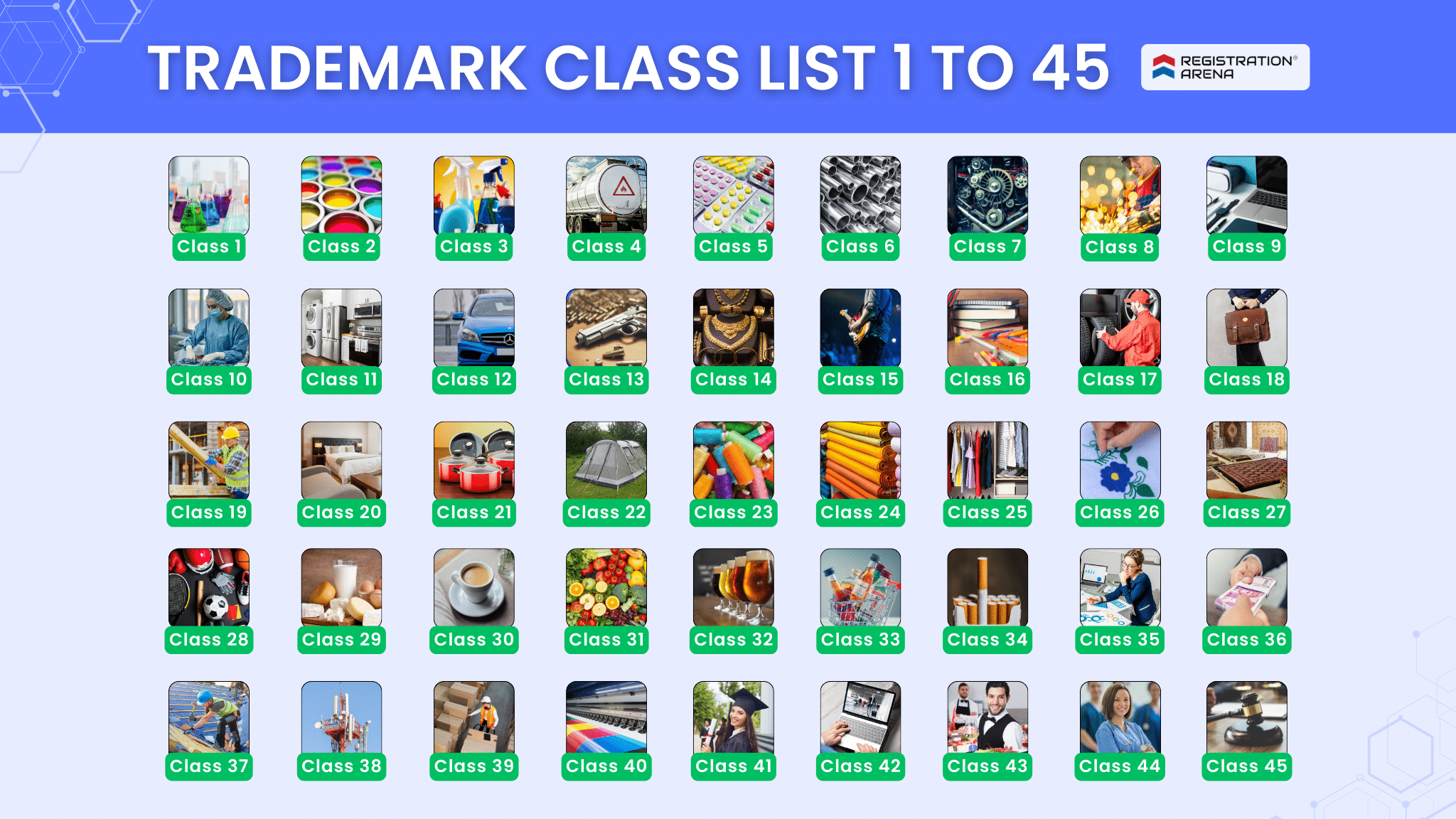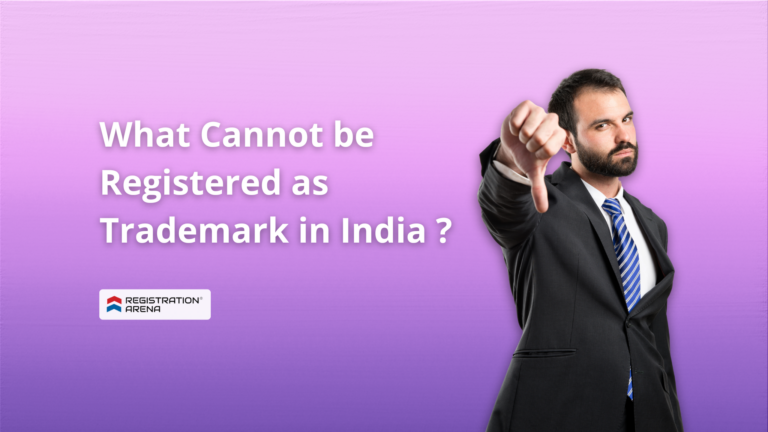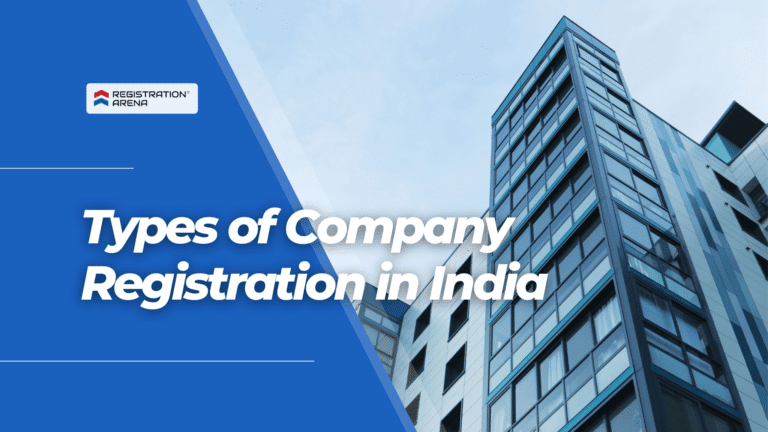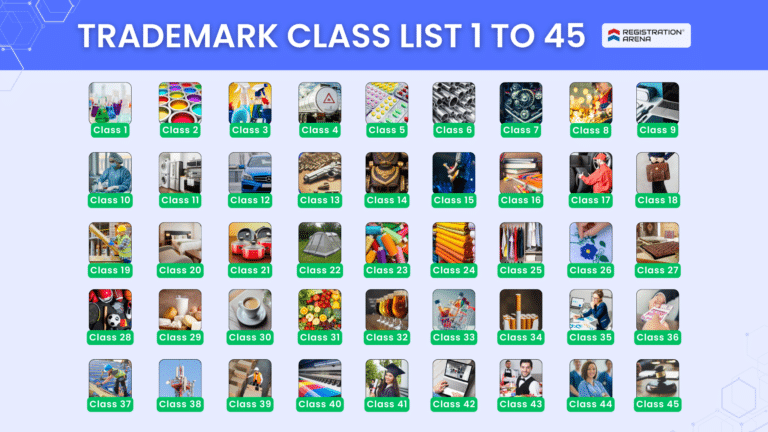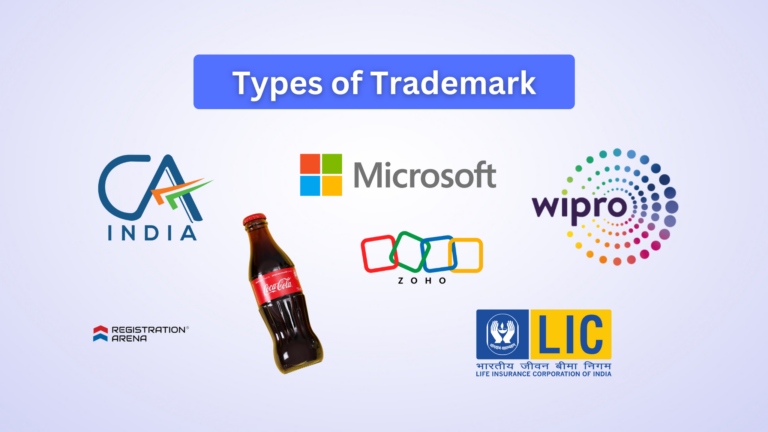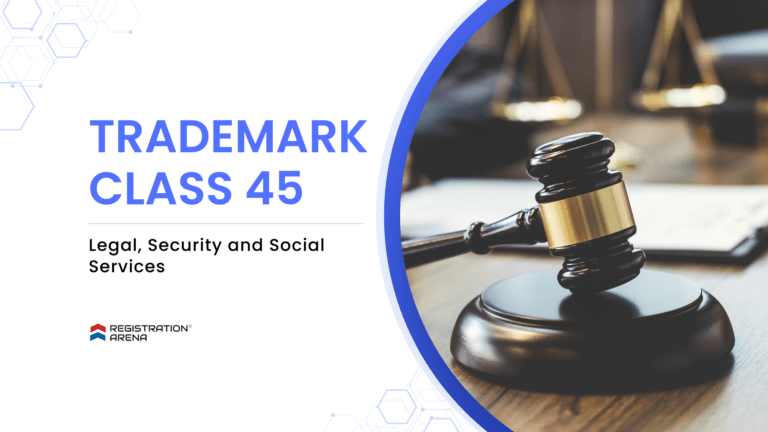What is a Trademark?
A Trademark is a recognizable word, sign, phrase, or symbol that denotes a specific product and legally differentiates that product from the rest of the similar products in the market. It helps the customer exclusively identify a product as belonging to a particular entity and recognize the entity’s ownership of the brand. Before we get into the Trademark Class List, let’s first understand what the Trademark Act is.
In India, the Trademark Act, 1999 governs the laws related to Trademarks. The Trademarks Act, 1999 defines a ‘mark’ under Section 2(1) (m) to include a device, brand, heading, label, ticket, name, signature, word, letter, numeral, shape of goods, packaging, or combination of colours or any combination thereof.
Further, the word “Trademark” has been defined under Section 2(zb) as a mark with a distinctive character that can be graphically represented and which is capable of distinguishing the goods or services of one person from others and may include the shape of goods, their packaging, and combination of colours and covers both goods and services.
Example: When you hear the word “Pepsi” you easily get to know that the logo and the name “Pepsi” belong to the company “PEPSICO”.
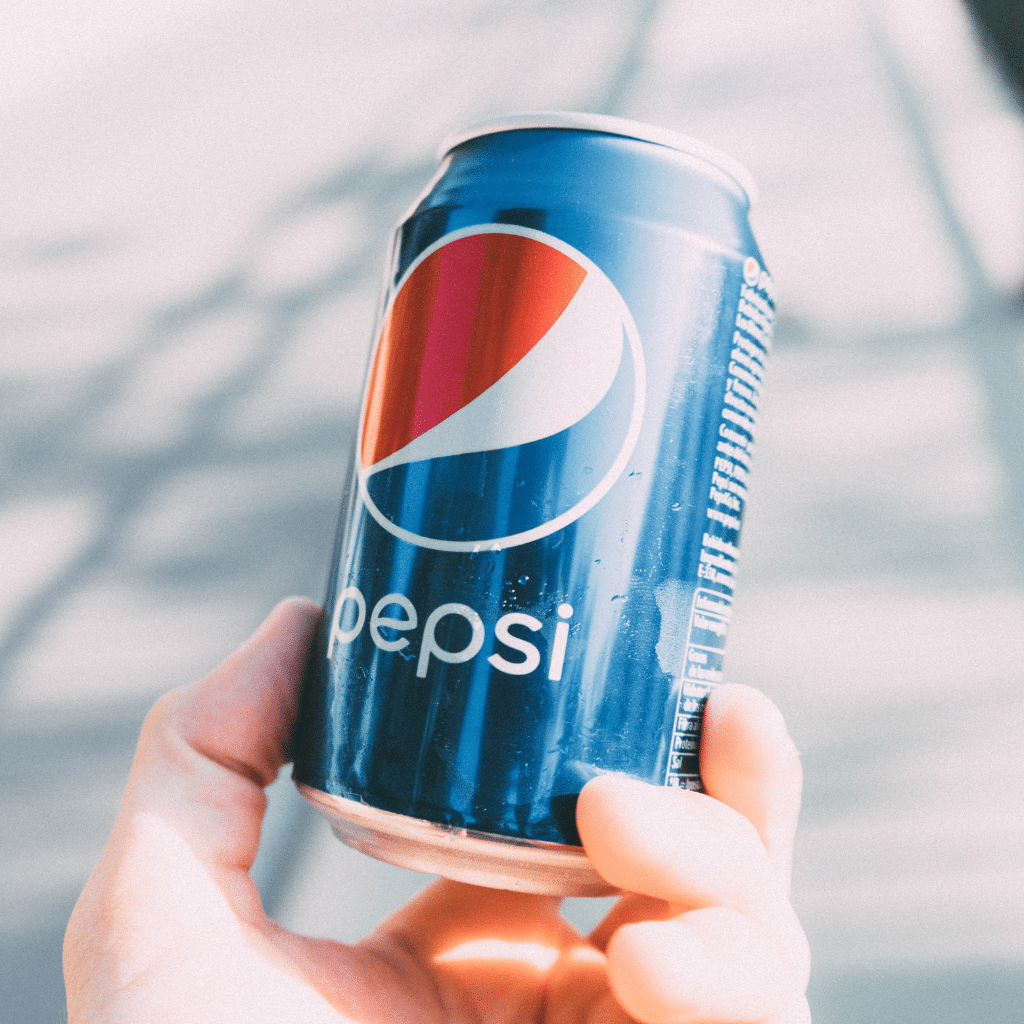
Source: Canva.com
Trademarks encourage innovation and business growth globally by rewarding their owners with recognition and financial benefits. Trademark protection also helps prevent unfair competition, such as counterfeiters using similar marks to sell inferior products or services. This system allows skilled individuals to produce and market their goods and services under fair conditions, ultimately facilitating international trade.
What Are Trademark Classes?
Trademark classes are groups designed to sort different kinds of goods and services when registering a trademark. There are 45 classes in total, covering everything from chemicals to clothing to services like advertising. Identifying the appropriate class is essential because trademarks are class-specific. This means that a trademark registered under one class (e.g., clothing) does not protect the same mark for goods or services in another class (e.g., electronics), unless it is registered there too.
The International Classification of Goods and Services, as per the NICE Agreement, divides products and services into 45 distinct categories. (classes 1-34 include goods and classes 35-45 include services). This classification system is widely recognized globally, making the process easier to apply for trademarks internationally. Every business entity, willing to register a trademark for a good or service, has to choose from the appropriate class, out of the 45 classes.
Significance of Trademark Classes in Business
The significance of trademark class in business is crucial because it assists businesses in protecting their brand within specific categories. Let’s see why identifying the right trademark from the trademark class list is important:
Clear Protection
It defines the exact goods or services under which the proposed trademark falls, preventing others from using a similar mark in the same category.
Avoid Conflicts
It helps avoid conflicts by ensuring that two similar trademarks can co-exist in different classes.
Proper Classification
Proper Classification of trademark classes is essential for effective trademark protection and enforcement.
Legal Security
Registering a trademark in the right class gives legal protection, making it easier to take action against infringement.
International Standardization
The trademark class system is recognized globally, simplifying international trademark registration for businesses expanding to new markets.
Business Identity
It allows businesses to build and safeguard their identity in their specific industry or sector.
In short, choosing the correct trademark class is crucial for securing brand identity and protection in business.
Trademark Class List 1 to 34 for Products
Trademark Class 1: Chemicals, Resins and Plastics
Trademark Class 1 is one of the Nice Classification, an international system used to categorize goods and services in the chemical industry for trademark registration purposes. Class 1 covers a wide range of products such as Chemicals for use in industry, science, and photography, as well as in agriculture, horticulture, and forestry; unprocessed artificial resins, and unprocessed plastics; fire extinguishing and fire prevention compositions; tempering and soldering preparations; substances for tanning animal skins and hides; adhesives for use in industry; putties and other paste fillers; compost, manures, fertilizers; biological preparations for use in industry and science.
- Industrial Use under Trademark Class 1: Trademark Class 1 is typically used by industries that deal with chemicals for industry, science, and agriculture, such as fertilizers, adhesives, and resins.
- Examples of Trademark Class 1: Ambuja Cements, TATA Chemicals Ltd, Reliance Industries Limited, Pidilite (Fevicol), IFFCO.
For more details, please read: Trademark Class 1 Chemicals, Resins, and Plastics which falls under the Trademark Class List.
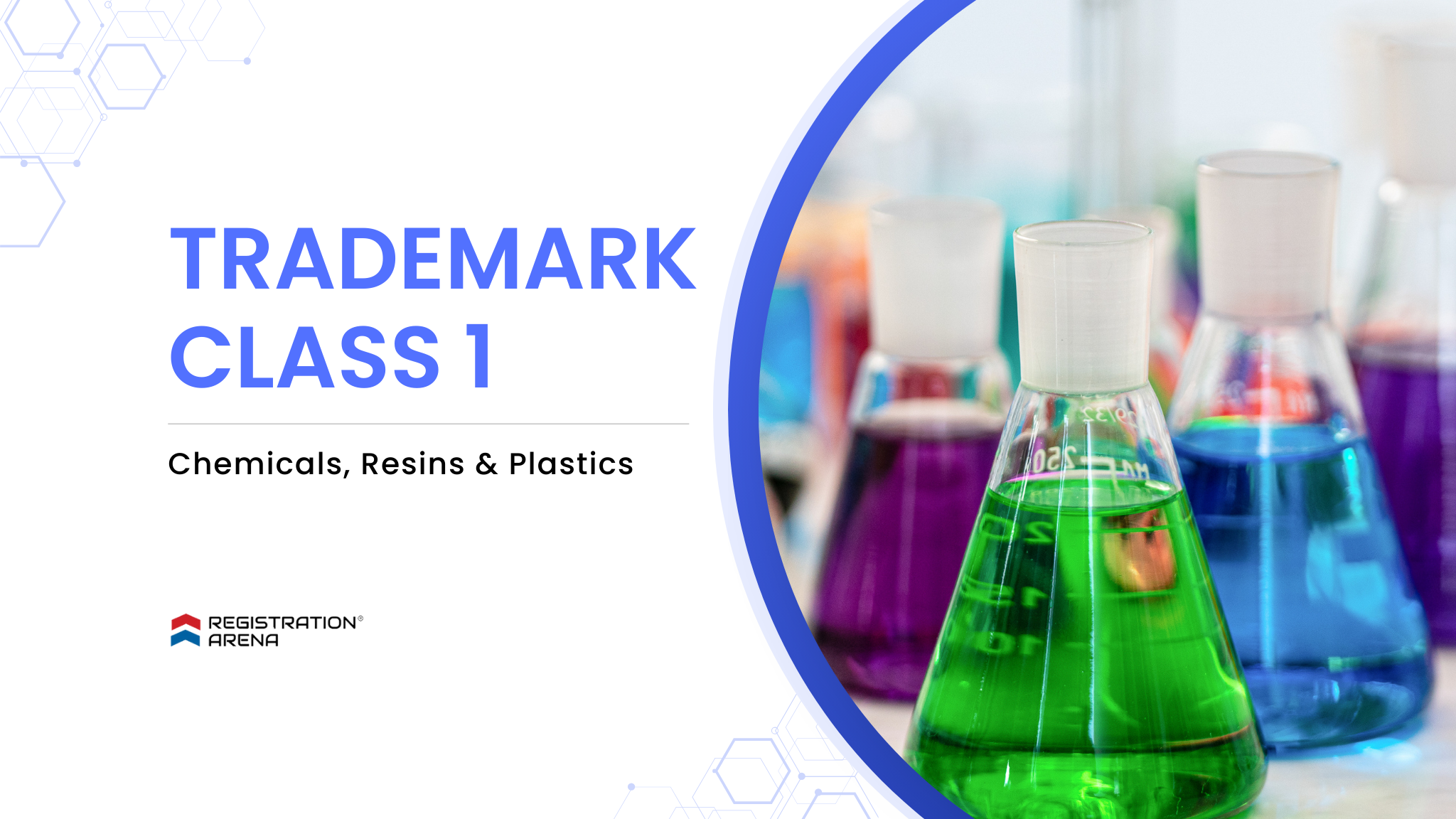
Trademark Class 2: Paints and Colorants
Trademark Class 2 falls under the Nice Classification, an international system used to categorize goods and services for trademark registration purposes. It encompasses a diverse range of products essential for various applications in painting, coating, and coloration. Class 2 primarily includes paints, colorants, and preparations used for protection against corrosion.
Examples of goods falling under this class include Wall paints, Automotive paints, Wood stains, Industrial coatings, Printing inks, Enamels, Pigments for textiles and cosmetics, and Artists’ paints and supplies.
- Industrial Use under Trademark Class 2: Trademark Class 2 is typically used by industries involved with paints, varnishes, and coatings including those in construction and manufacturing.
- Examples of Trademark Class 2: Asian Paints Ltd, Kansai Nerolac Paints Limited, Berger Paints, Sudarshan.
For more details, please read: Trademark Class 2 Paints and Colorants which falls under the Trademark Class List.

Trademark Class 3: Cosmetics and Cleaning Products
Trademark Class 3 includes a wide range of goods in the categories of cosmetics and cleaning preparations. Trademark Class 3 covers Non-medicated cosmetics and toiletry preparations; non-medicated dentifrices; perfumery, essential oils; bleaching preparations and other substances for laundry use; cleaning, polishing, and abrasive preparations.
This class is essential for products used in personal care and household cleaning, ensuring they are properly categorized for trademark registration purposes.
- Industrial Use under Trademark Class 3: Trademark Class 3 is typically used by beauty and skincare industries dealing with products such as cosmetics, perfumes, and cleaning items.
- Examples of Trademark Class 3: Nivea, Fogg Xtremo, Sunsilk Hair Shampoo, Lizol, Sugar Cosmetics, and Colgate Toothpaste.
For more details, please read: Trademark Class 3 Cosmetics and Cleaning Products which falls under the Trademark Class List.
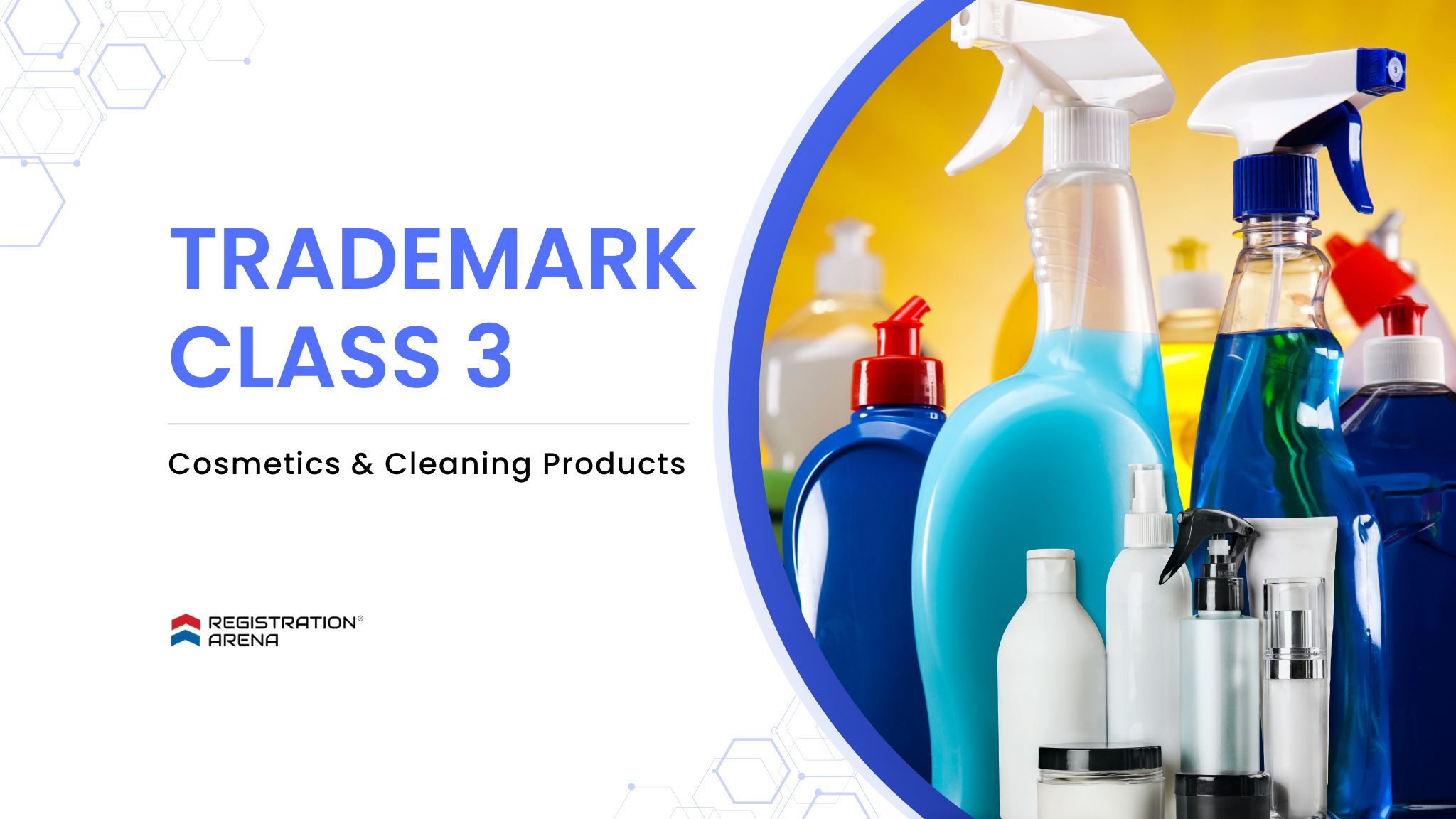
Trademark Class 4: Industrial Oils, Fuels and Illuminates
Trademark Class 4 plays an important role in mechanics and mobility covering essential fluids that power, lubricate, and ensure the smooth operation of machinery and vehicles while minimizing friction. Trademark Class 4 covers Industrial oils and greases, wax; lubricants; dust absorbing, wetting, and binding compositions; fuels and illuminants; candles and wicks for lighting. This class includes mainly industrial oils and greases, fuels, and illuminants.
- Industrial Use under Trademark Class 4: Trademark Class 4 is typically used by industries involved with lubricants, fuels, and energy products, including items such as oils, greases, and industrial oils.
- Examples of Trademark Class 4: Castrol, Shell, Indian Oil Corporation Limited, Bharat Petroleum Corporation Limited (BPCL), Archies Candles.
For more details, please read: Trademark Class 4 Cosmetics and Cleaning Products which falls under the Trademark Class List.
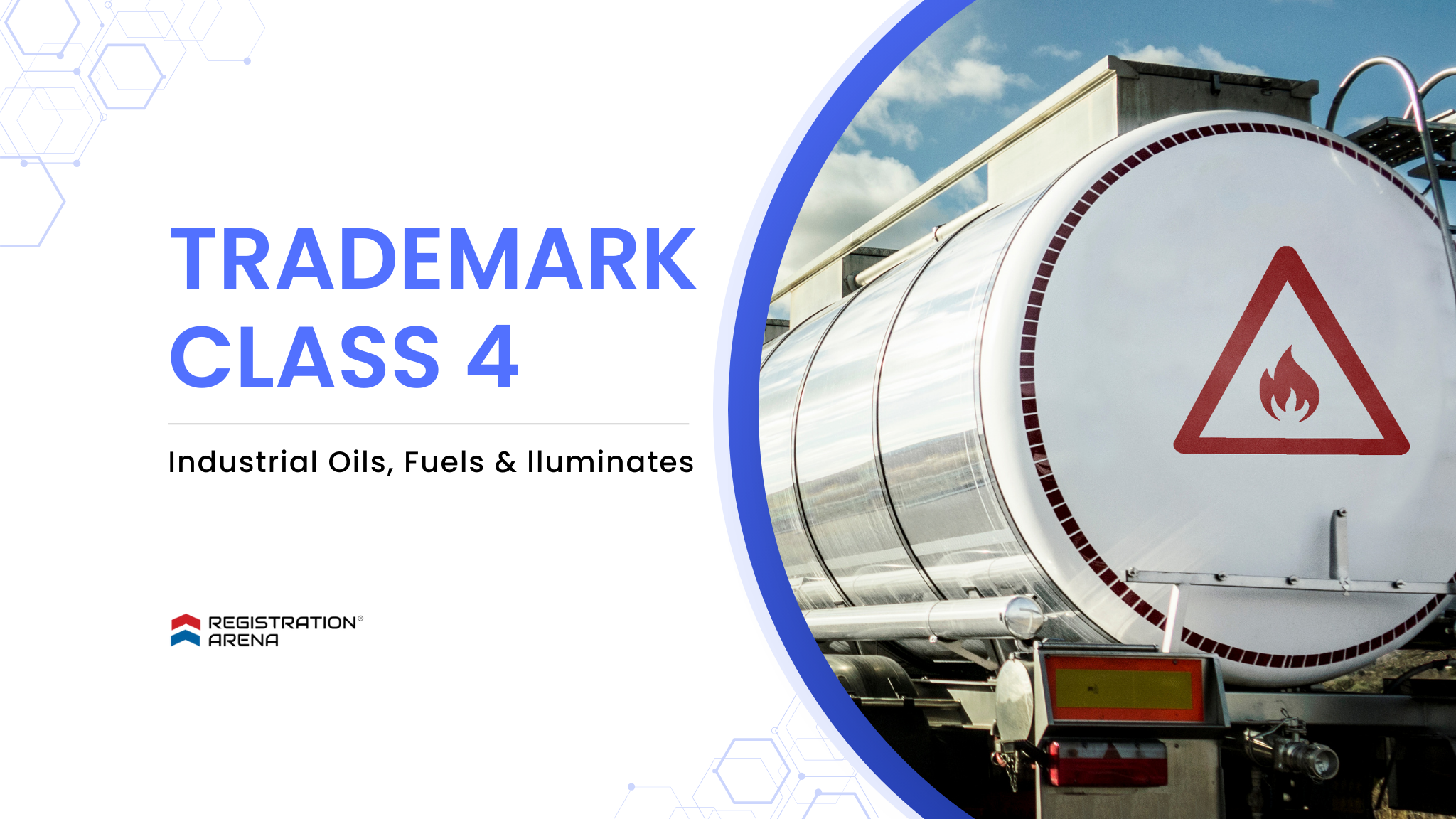
Trademark Class 5: Pharmaceuticals, Medical & Sanitary Preparations
Trademark Class 5 encompasses a broad spectrum of pharmaceutical products, ranging from life-saving medications to everyday remedies for minor ailments.
This class represents the intersection of science, compassion, and innovation and covers products such as Pharmaceuticals, medical and veterinary preparations; sanitary preparations for medical purposes; dietetic food and substances adapted for medical or veterinary use, food for babies; dietary supplements for human beings and animals; plasters, materials for dressings; material for stopping teeth, dental wax; disinfectants; preparations for destroying vermin; fungicides, herbicides. It includes mainly pharmaceuticals and other preparations for medical or veterinary purposes.
- Industrial Use under Trademark Class 5: Trademark Class 5 is typically used by pharmaceutical and healthcare industries, dealing with products such as medicines and dietary supplements.
- Examples of Trademark Class 5: Emcure Pharmaceuticals Limited, Serum Institute of India Pvt. Ltd., Nestle Cerelac Fortified Baby Cereal, Nutrionalab Pvt Ltd, Abiba Pharmacia, Himalaya Baby Care.
For more details, please read: Trademark Class 5 Pharmaceuticals, Medical & Sanitary Preparations which falls under the Trademark Class List.
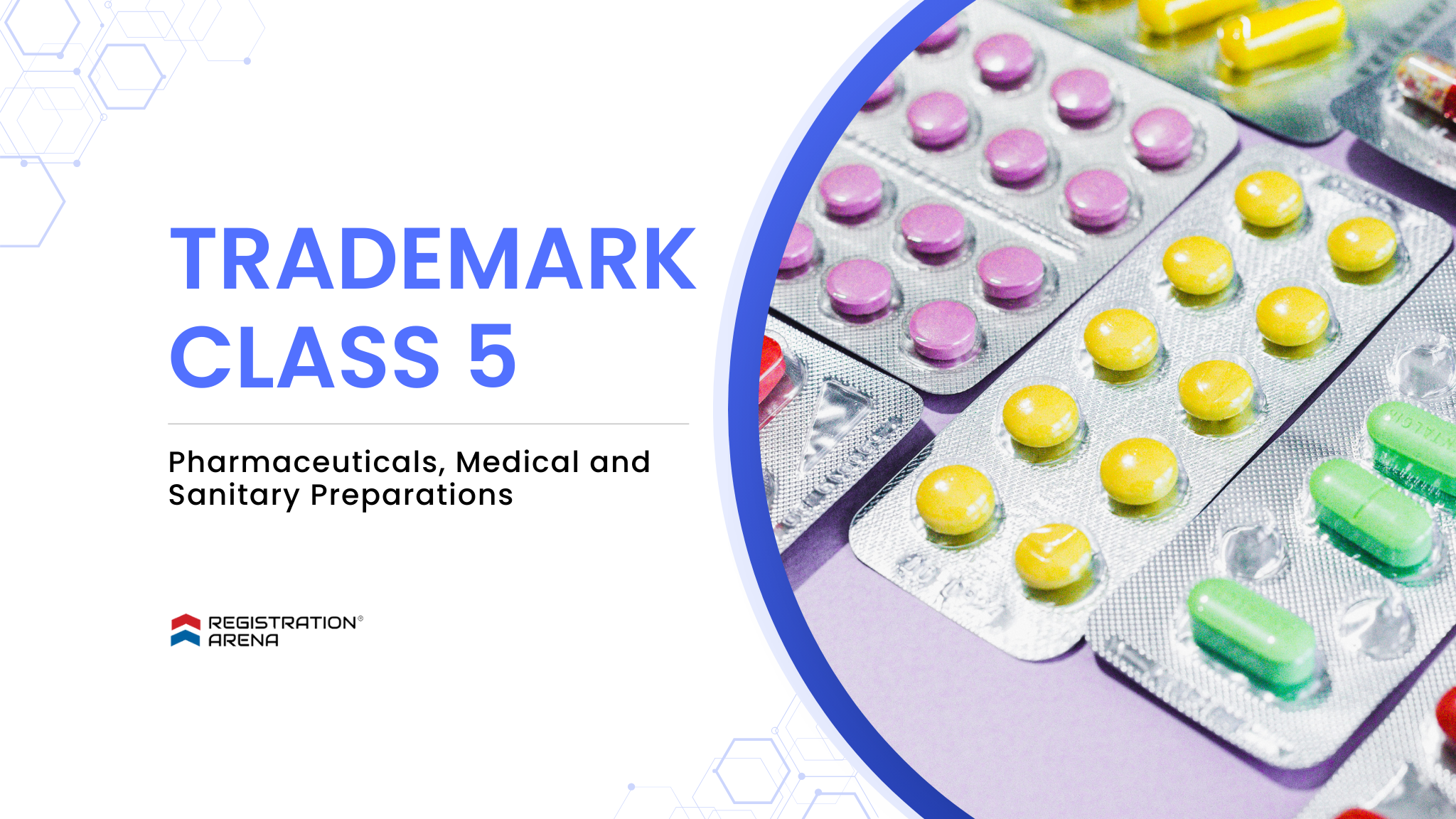
Trademark Class 6: Metal Goods & Alloys
Trademark Class 6 is one of the NICE classifications that plays an important role in the manufacturing and construction industry ranging from large architectural structures to everyday tools. It comprises a wide range of products such as common metals and their alloys, and ores; metal materials for building and construction; transportable buildings of metal; non-electric cables and wires of common metal; small items of metal hardware; metal containers for storage or transport; and safes. It includes mainly unwrought and partly wrought common metals, including ores, as well as certain goods made of common metals.
- Industrial Use under Trademark Class 6: Trademark Class 6 is typically used by industries involved with metal products, including those in construction, engineering, and metal manufacturing.
- Examples of Trademark Class 6: Tata Steel, SAIL (Steel Authority of India Limited), Thyssenkrupp, KEI Industries Limited, JSW Steel, Godrej & Boyce.
For more details, please read: Trademark Class 6 Metal Goods & Alloys which falls under the Trademark Class List.
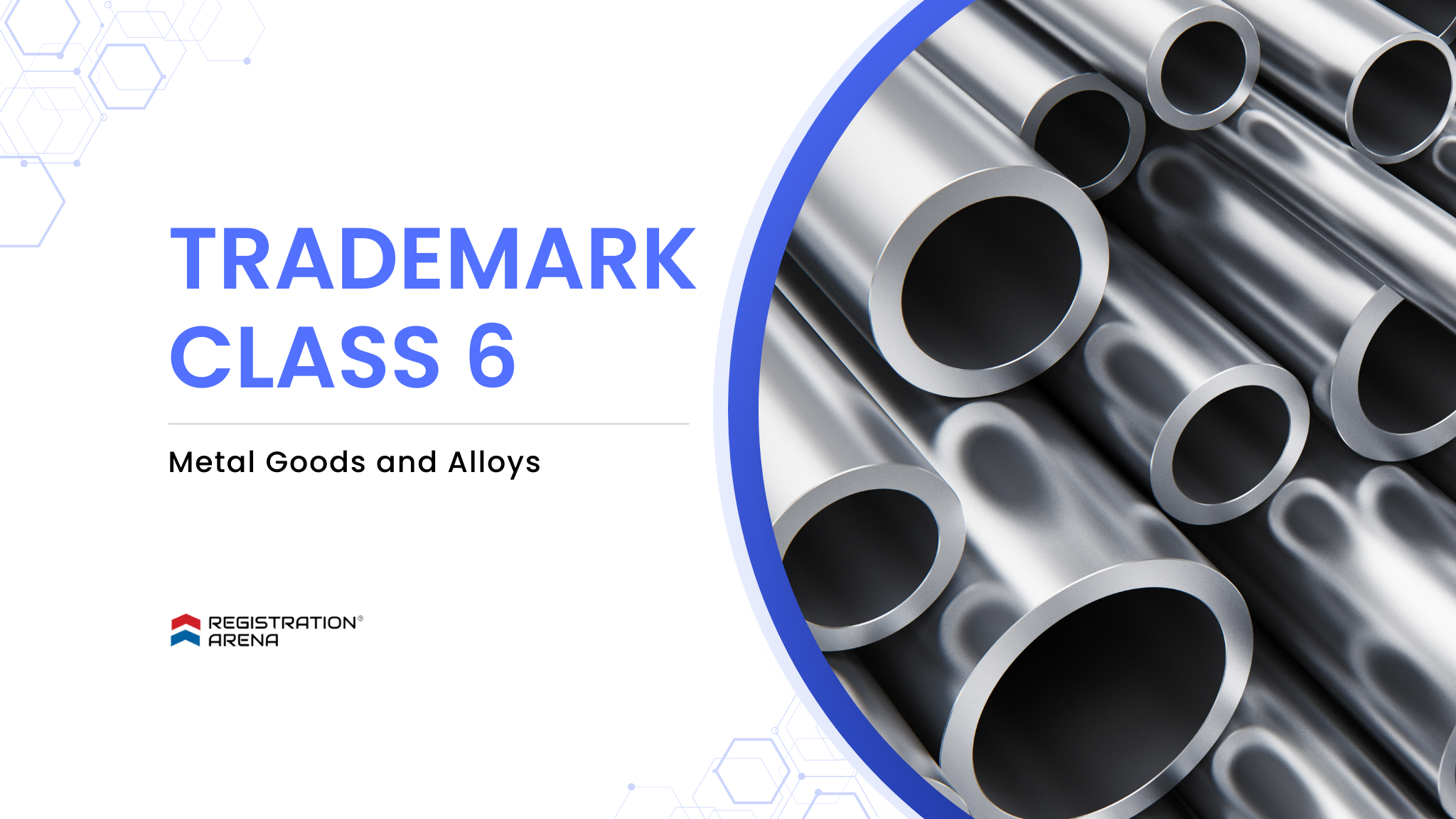
Trademark Class 7: Machine and Machine Tools
Trademark Class 7 encompasses a wide range of machinery and tools that drive manufacturing, construction, and innovation across various sectors. This class assembles gears, motors, and intricate mechanisms that support manufacturing processes and drive technological advancement and covers a diverse range of products such as Machines, machine tools, power-operated tools; motors and engines, except for land vehicles; machine coupling and transmission components, except for land vehicles; agricultural implements, other than hand-operated hand tools; incubators for eggs; automatic vending machines. It primarily includes mainly machines and machine tools, motors, and engines.
- Industrial Use under Trademark Class 7: Trademark Class 7 is typically used by industries such as manufacturing, agriculture, construction, and industrial automation dealing with products such as Industrial machines, agricultural equipment, and construction tools.
- Examples of Trademark Class 7: TATA, Kirloskar Oil Engines Limited, L&T (Larsen & Toubro), Mahindra & Mahindra, Kuka.
For more details, please read: Trademark Class 7 Machine and Machine Tools which falls under the Trademark Class List.

Trademark Class 8: Hand Tools for Drilling, Cutting, Shaping
Trademark Class 8 comprises various hand tools for cutting, shaping, fastening, and assembling materials. From construction sites, and workshops to repairs, this class plays an important role in providing essential tools for hands-on creativity and skill and covers a diverse range of products such as Hand tools and implements, hand-operated; cutlery; side arms, except firearms; and razors. It primarily includes hand-operated tools and implements for performing tasks, such as drilling, shaping, cutting, and piercing.
- Industrial Use under Trademark Class 8: Trademark Class 8 is typically used by industries such as Construction, DIY, and gardening dealing with products such as Hand tools like wrenches, saws, and hammers.
- Examples of Trademark Class 8: Taparia Tools Limited, Tata Agrico, Gillette, Nova.
For more details, please read: Trademark Class 8 Hand Tools for Drilling, Cutting, Shaping which falls under the Trademark Class List.

Trademark Class 9: Scientific Electrical and Computer products
Trademark Class 9 comprises various products that promote communication, data processing, measurement, and exploration across multiple fields.
From communication to exploration, this class is the driver of scientific advancement and innovation and covers a diverse range of products such as Scientific, research, navigation, surveying, photographic, cinematographic, audiovisual, optical, weighing, measuring, signalling, detecting, testing, inspecting, life-saving and teaching apparatus and instruments; apparatus and instruments for conducting, switching, transforming, accumulating, regulating or controlling the distribution or use of electricity; apparatus and instruments for recording, transmitting, reproducing or processing sound, images or data; recorded and downloadable media, computer software, blank digital or analogue recording and storage media; mechanisms for coin-operated apparatus; cash registers, calculating devices; computers and computer peripheral devices; diving suits, divers’ masks, ear plugs for divers, nose clips for divers and swimmers, gloves for divers, breathing apparatus for underwater swimming; fire-extinguishing apparatus.
It primarily includes apparatus and instruments for scientific or research purposes, audiovisual and information technology equipment, and safety and life-saving equipment.
- Industrial Use under Trademark Class 9: Trademark Class 9 is commonly used by industries such as technology, electronics, and research for products like Measuring instruments, computers, software, electronic devices, and laboratory equipment.
- Examples of Trademark Class 9: Thermo Fisher Scientific India, Whirlpool, Samsung, Sony, Lenovo, and Cressi.
For more details, please read: Trademark Class 9 Scientific Electrical and Computer Products which falls under the Trademark Class List.

Trademark Class 10: Surgical, Medical and Veterinary Apparatus
Trademark Class 10 represents a symbol of progress and healing in medicine and veterinary care. This class is the point where innovation and compassion meet to create tools, instruments, devices, and apparatus used by doctors and veterinarians for diagnosing, treating, and improving the lives of people and animals.
From precise surgical tools and advanced diagnostic equipment, this class is essential for improving healthcare outcomes and covers a diverse range of products such as Surgical, medical, dental, and veterinary apparatus and instruments; artificial limbs, eyes, and teeth; orthopedic articles; suture materials; therapeutic and assistive devices adapted for persons with disabilities; massage apparatus; apparatus, devices, and articles for nursing infants; sexual activity apparatus, devices and articles.
It primarily includes surgical, medical, dental, and veterinary apparatus, instruments and articles generally used for diagnosing, treating, or improving the function or condition of persons and animals.
- Industrial Use under Trademark Class 10: Trademark Class 10 is commonly used by Healthcare, and medical research industries dealing in products like Surgical instruments, diagnostic equipment, medical devices, and prosthetics.
- Examples of Trademark Class 10: GPC Medical Ltd, Dr. Reddy’s Laboratories, Apollo Hospitals, GE Healthcare India, Johnson & Johnson, Mankind Prega News.
For more details, please read: Trademark Class 10 Surgical, Medical, and Veterinary Apparatus which falls under the Trademark Class List.

Trademark Class 11: Lighting, Heating, Cooling & Cooking
Trademark Class 11 acts as a guardian of comfort and well-being, playing a crucial role in shaping our living environment. This class is the intersection where technology and nature meet to create devices that regulate temperature, humidity, and air quality which helps in fostering comfortable and harmonious living and working environments.
From cooling our homes during hot weather with air conditioners to maintaining optimal air quality through air purifiers, these products are essential for creating a stable and favorable environment and cover a diverse range of products such as Apparatus and installations for lighting, heating, cooling, steam generating, cooking, drying, ventilating, water supply and sanitary purposes. It primarily includes environmental control apparatus and installations, in particular, for the purposes of lighting, cooking, cooling, and sanitizing.
- Industrial Use under Trademark Class 11: Trademark Class 11 is commonly used by Construction, energy, and HVAC industries for products such as Air conditioning units, heaters, lighting fixtures, and ventilation systems.
- Examples of Trademark Class 11: Daikin Industries, Ltd., TTK Prestige, Bajaj Electricals, Thermax, LG, Kent.
For more details, please read: Trademark Class 11 Lighting, Heating, Cooling & Cooking which falls under the Trademark Class List.
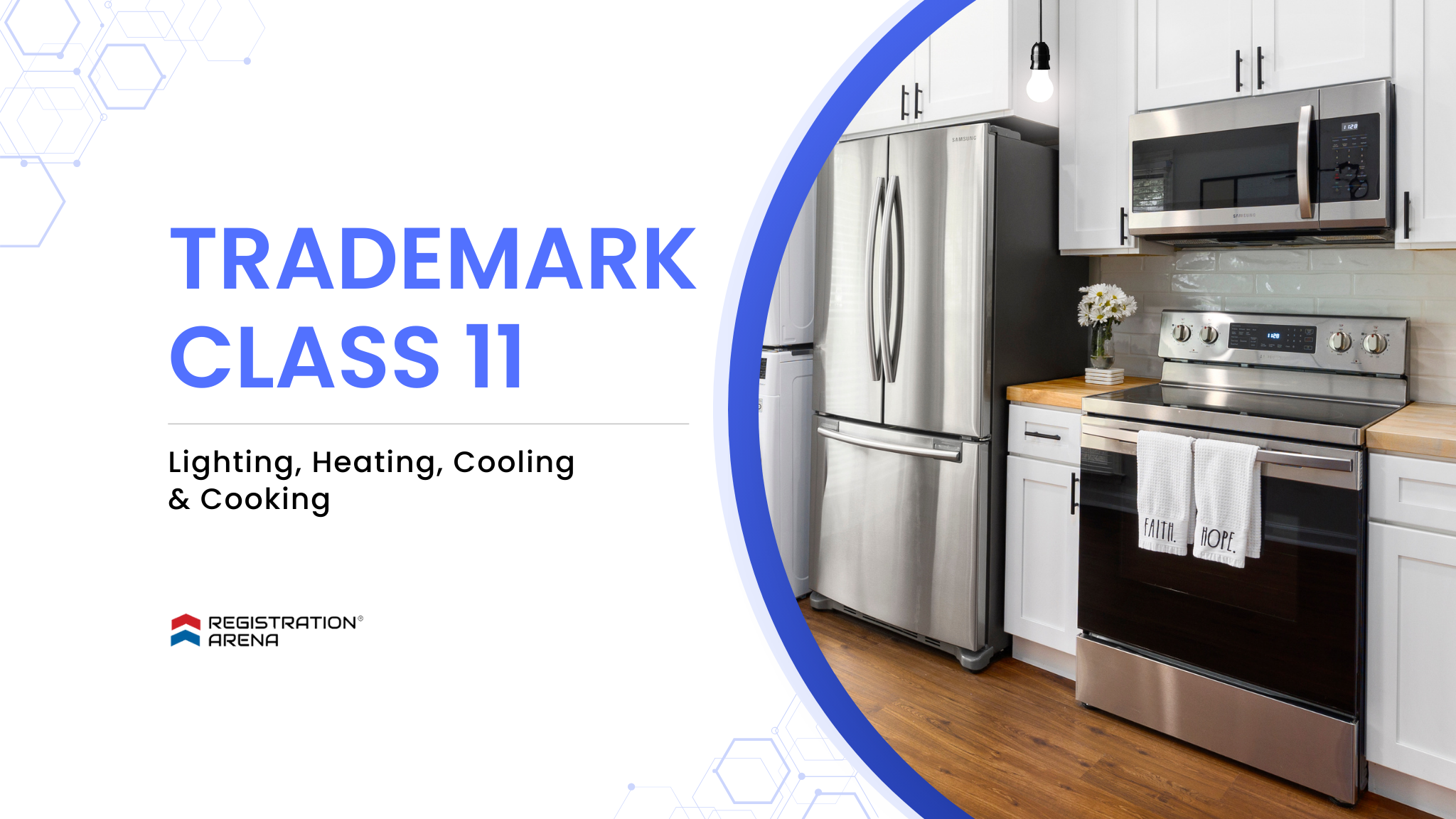
Trademark Class 12: Vehicles and Apparatus
Trademark Class 12 is the foundation for exploring and experiencing mobility-related innovations and technologies. This class encompasses new ideas and creations that have made everyday travel and adventurous journeys easier, bringing people together and changing how we think about getting around.
From automobiles to bicycles and more, Class 12 shapes our ability to connect and embark on journeys that define our experiences and cover a diverse range of products such as Vehicles; and apparatus for locomotion by land, air, or water. It includes mainly vehicles and apparatus for the transport of people or goods by land, air, or water.
- Industrial Use under Trademark Class 12: Trademark Class 12 is commonly used by industries such as Automotive, aerospace, marine, and public transportation dealing with products such as Cars, airplanes, boats, bicycles, parts, and accessories for vehicles.
- Examples of Trademark Class 12: Maruti Suzuki, Firefox, Air India, Cordelia Cruises, Bajaj Auto Limited.
For more details, please read: Trademark Class 12 Vehicles and Apparatus which falls under the Trademark Class List.

Trademark Class 13: Firearms and Fireworks
Trademark Class 13 represents precision and power, including weapons and tools like guns and ammunition that have shaped history. Covering areas from national defense to competitive shooting, this class highlights where innovation and accuracy meet. This class is a blend of engineering, strategy, and ethics in weaponry. It involves the art and science of creating tools for both protection and recreation, emphasizing their historical and modern significance. This class encompasses a wide range of products such as firearms; ammunition and projectiles; explosives; and fireworks. It includes mainly firearms and pyrotechnic products.
- Industrial Use under Trademark Class 13: Trademark Class 13 is commonly used by industries such as Defense, security, and sporting goods dealing with products such as Guns, ammunition, explosives, and firearm accessories.
- Examples of Trademark Class 13: TATA, Munitions India, Reliance, Bharat Dynamics Limited (BDL), Ajanta Fireworks Industries.
For more details, please read: Trademark Class 13 Firearms and Fireworks which falls under the Trademark Class List.
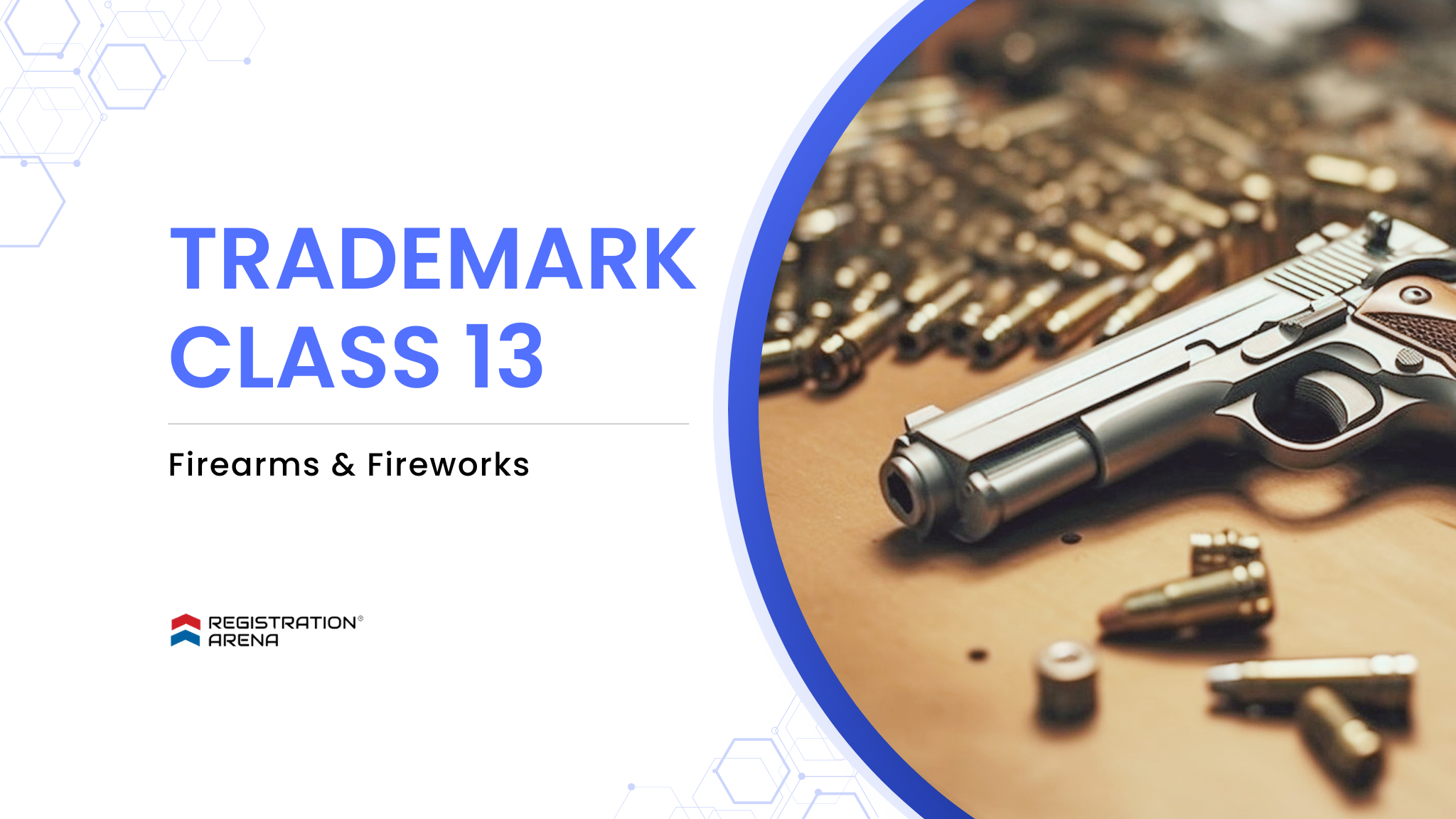
Trademark Class 14: Jewellery, Precious Metals and Stones
Trademark Class 14 stands as a symbol of timeless elegance and lasting value. This class deals with valuable and high-end materials like gold, silver, and platinum, commonly used in jewelry and luxury items highlighting their elegance and quality.
From the shine of gemstones to the glow of precious metals, the items in this class have a timeless beauty that captures human dreams and desires. This class encompasses a wide range of products such as Precious metals and their alloys; jewellery, precious and semi-precious stones; horological and chronometric instruments. It includes mainly precious metals and certain goods made of precious metals or coated therewith, as well as jewellery, clocks and watches, and component parts therefor.
- Industrial Use under Trademark Class 14: Trademark Class 14 is commonly used by industries such as Jewelry, luxury goods, and horology dealing with products such as Rings, necklaces, watches, gold, and silver.
- Examples of Trademark Class 14: Malabar Gold, GIVA, Tanishq, Joyalukkas, Reliance, Titan, Ranka Jewellers.
For more details, please read: Trademark Class 14 Jewellery, Precious Metals and Stones which falls under the Trademark Class List.
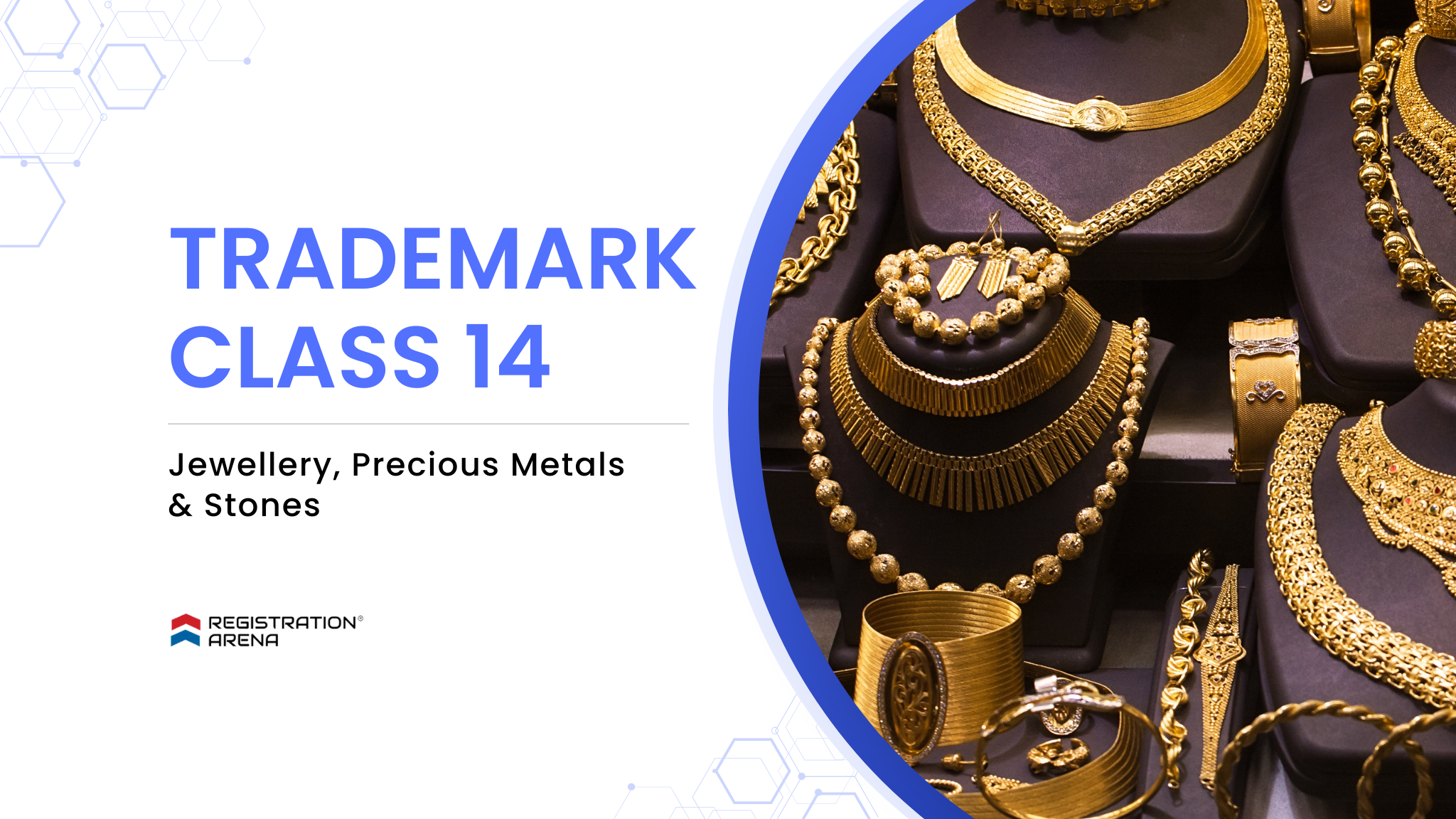
Trademark Class 15: Musical Instruments and Accessories
Trademark Class 15 is a vital category, featuring the instruments that bring human emotions and creativity to life through music. Covering a broad spectrum of instruments from different cultures and genres, this class includes everything from string and woodwind instruments to percussion and keyboard instruments.
It is a combination of both artistic craftsmanship and the universal language of music. This class encompasses a wide range of products such as musical instruments; music stands and stands for musical instruments; conductors’ batons. It mainly includes musical instruments, their parts, and their accessories.
- Industrial Use under Trademark Class 15: Trademark Class 15 is commonly used by industries such as Music, and entertainment dealing with products such as Guitars, pianos, drums, and wind instruments.
- Examples of Trademark Class 15: Yamaha, Chateau, Alesis, Korg, Hercules, Jupiter, Magnum.
For more details, please read: Trademark Class 15 Musical Instruments and Accessories which falls under the Trademark Class List.

Trademark Class 16: Paper, Printed Material and Stationery
Trademark Class 16 serves as a platform where ideas, stories, and creativity take shape and come to life. From books that take us to new places to stationery that helps us create, this class brings together imagination and expression shaping how we communicate and connect.
It includes a variety of materials essential for sharing information, expressing emotions, and engaging with the world. This class encompasses a wide range of products such as Paper and cardboard; printed matter; bookbinding material; photographs; stationery and office requisites, except furniture; adhesives for stationery or household purposes; drawing materials and materials for artists; paintbrushes; instructional and teaching materials; plastic sheets, films and bags for wrapping and packaging; printers’ type, printing blocks. It mainly includes paper, cardboard, and certain goods made of those materials, as well as office requisites.
- Industrial Use under Trademark Class 16: Trademark Class 16 is commonly used by Publishing, stationery, and education industries for products such as Books, newspapers, office supplies, and printed materials.
- Examples of Trademark Class 16: Hindustan Times, Doms, Maps of India, Navneet, Archies, and Classmate.
For more details, please read: Trademark Class 16 Paper, Printed Material and Stationery which falls under the Trademark Class List.

Trademark Class 17: Rubber, Mica and Asbestos Products
Trademark Class 17 represents a world of elasticity and adaptability, encompassing products made from rubber and similar materials that are utilized across various industries. It is vital in creating products that stretch, protect, and insulate, ranging from everyday necessities to industrial innovations.
This class encompasses a wide range of products such as Unprocessed and semi-processed rubber, gutta-percha, gum, asbestos, mica, and substitutes for all these materials; plastics and resins in extruded form for use in manufacture; packing, stopping, and insulating materials; flexible pipes, tubes, and hoses, not of metal.
It mainly includes electrical, thermal, and acoustic insulating materials and plastics for use in manufacture in the form of sheets, blocks, and rods, as well as certain goods made of rubber, gutta-percha, gum, asbestos, mica, or substitutes.
- Industrial Use under Trademark Class 17: Trademark Class 17 is commonly used by Manufacturing, construction, automotive, and packaging industries for products such as Rubber gaskets, plastic packaging, insulation materials, and synthetic resins.
- Examples of Trademark Class 17: RUBCO, MRF Ltd, Goodyear, Sealmax, TVS Rubber, Polymax.
For more details, please read: Trademark Class 17 Rubber, Mica, and Asbestos Products which falls under the Trademark Class List.
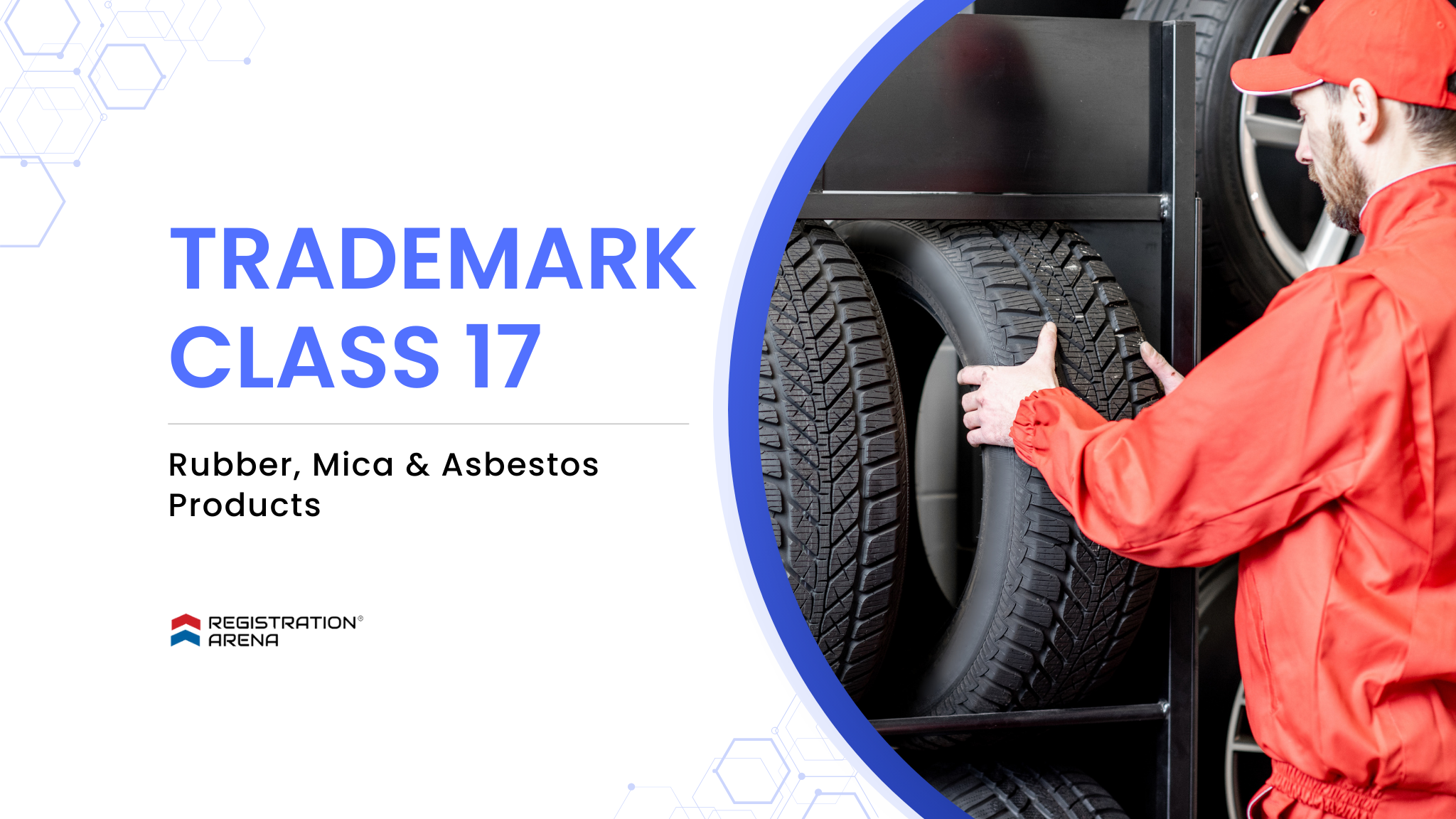
Trademark Class 18: Leather Goods, Travel Bags and Umbrella
Trademark Class 18 represents a perfect blend of style, practicality, and lasting quality. It is a collection of sophisticated leather products including a variety of items, from fashion accessories to everyday essentials, all carefully crafted from durable and versatile leather. From bags that hold our essentials to accessories that complement our outfits, this class is where beauty and practicality come together in fashion and beyond.
This class encompasses a wide range of products such as Leather and imitations of leather; animal skins and hides; luggage and carrying bags; umbrellas and parasols; walking sticks; whips, harnesses, and saddlery; collars, leashes, and clothing for animals. It mainly includes leather, imitations of leather, and certain goods made of those materials.
- Industrial Use under Trademark Class 18: Trademark Class 18 is commonly used by Fashion, automotive, and accessories industries dealing in products such as Bags, belts, and upholstery.
- Examples of Trademark Class 18: Hidedesign, Da Milano, Tommy Hilfiger, VIP, Destinio.
For more details, please read: Trademark Class 18 Leather Goods, Travel Bags and Umbrella which falls under the Trademark Class List.
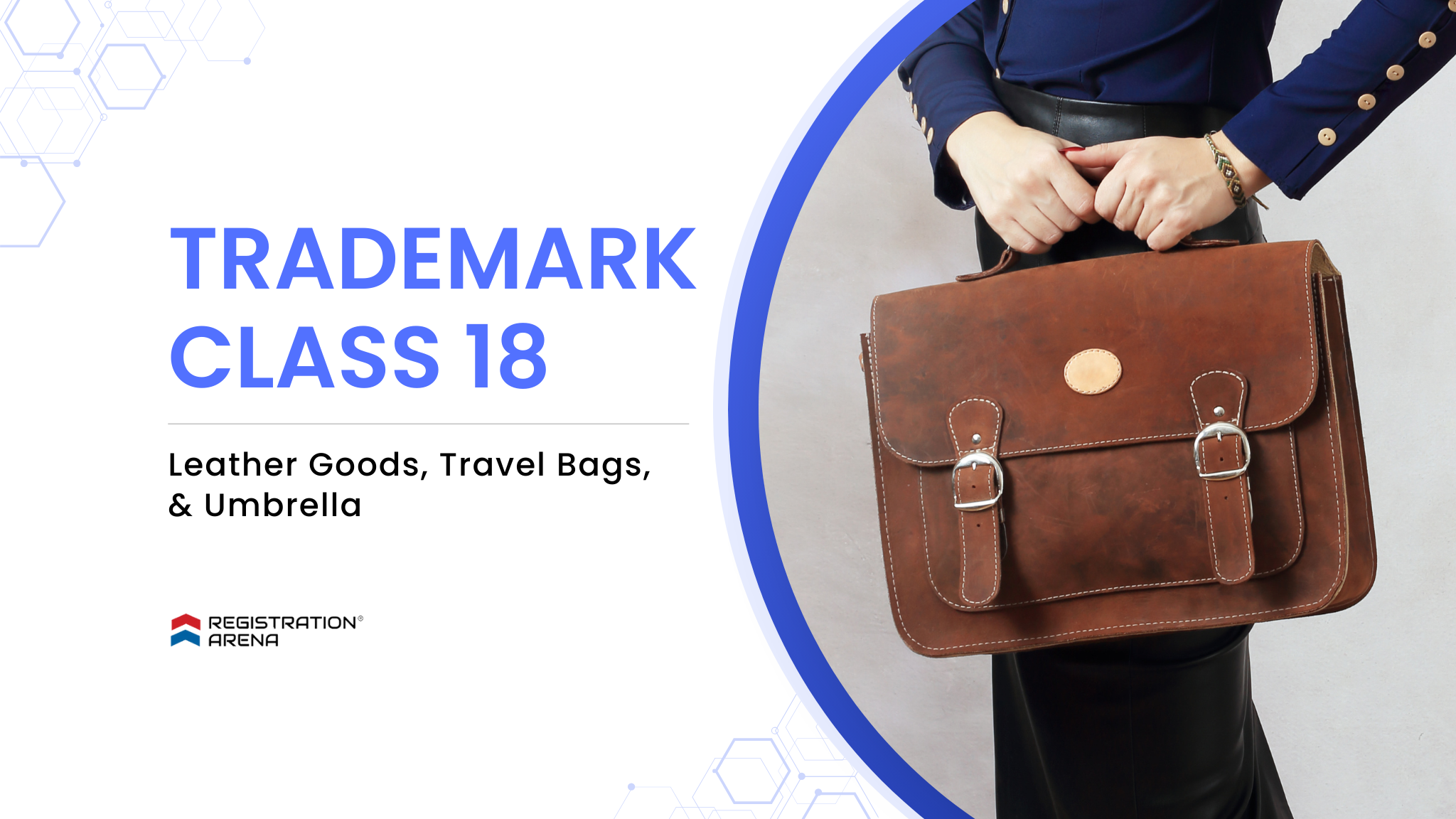
Trademark Class 19: Non-Metallic Building Materials
Trademark Class 19 is the foundation of architectural creativity and structural integrity, including a diverse range of materials used in construction, renovation, and design projects. From the bricks that build walls to the tiles that cover floors to other building materials that help shape our homes, offices, and landmarks, this class is where innovation and construction materials come together to create enduring spaces.
This class encompasses a wide range of products such as Materials, not of metal, for building and construction; rigid pipes, not of metal, for building; asphalt, pitch, tar, and bitumen; transportable buildings, not of metal; monuments, not of metal. It mainly includes materials, not metal, for building and construction.
- Industrial Use under Trademark Class 19: Trademark Class 19 is commonly used by Construction, architecture industries for products such as Cement, bricks, and tiles.
- Examples of Trademark Class 19: Hindware Italian Tiles, Finolex Industries Ltd., Saint-Gobain Glass India, Greenply, Everest Industries Limited.
For more details, please read: Trademark Class 19 Non-Metallic Building Materials which falls under the Trademark Class List.

Trademark Class 20: Furniture, Mirrors and Home Decor
Trademark Class 20 is the intersection where function meets style, covering items such as furniture, decorations, and other items that fill our homes, offices, and public spaces. From comfortable chairs to decorative pieces that enhance the ambiance, this class shapes how we experience our surroundings.
This class covers a variety of objects that combine functionality with design and personal style such as Furniture, mirrors, and picture frames; containers, not of metal, for storage or transport; unworked or semi-worked bone, horn, whalebone, or mother-of-pearl; shells; meerschaum; yellow amber.
It mainly includes furniture and parts therefor, as well as certain goods made of wood, cork, reed, cane, wicker, horn, bone, ivory, whalebone, shell, amber, mother-of-pearl, meerschaum, and substitutes for all these materials, or of plastic.
- Industrial Use under Trademark Class 20: Trademark Class 20 is typically used by Furniture, and home decor industries dealing with products such as Tables, chairs, and mirrors.
- Examples of Trademark Class 20: Godrej Interio, Hometown, Urban Ladder, Sleepwell, Fab India, and the Bombay Store.
For more details, please read: Trademark Class 20: Furniture, Mirrors, and Home Decor which falls under the Trademark Class List.
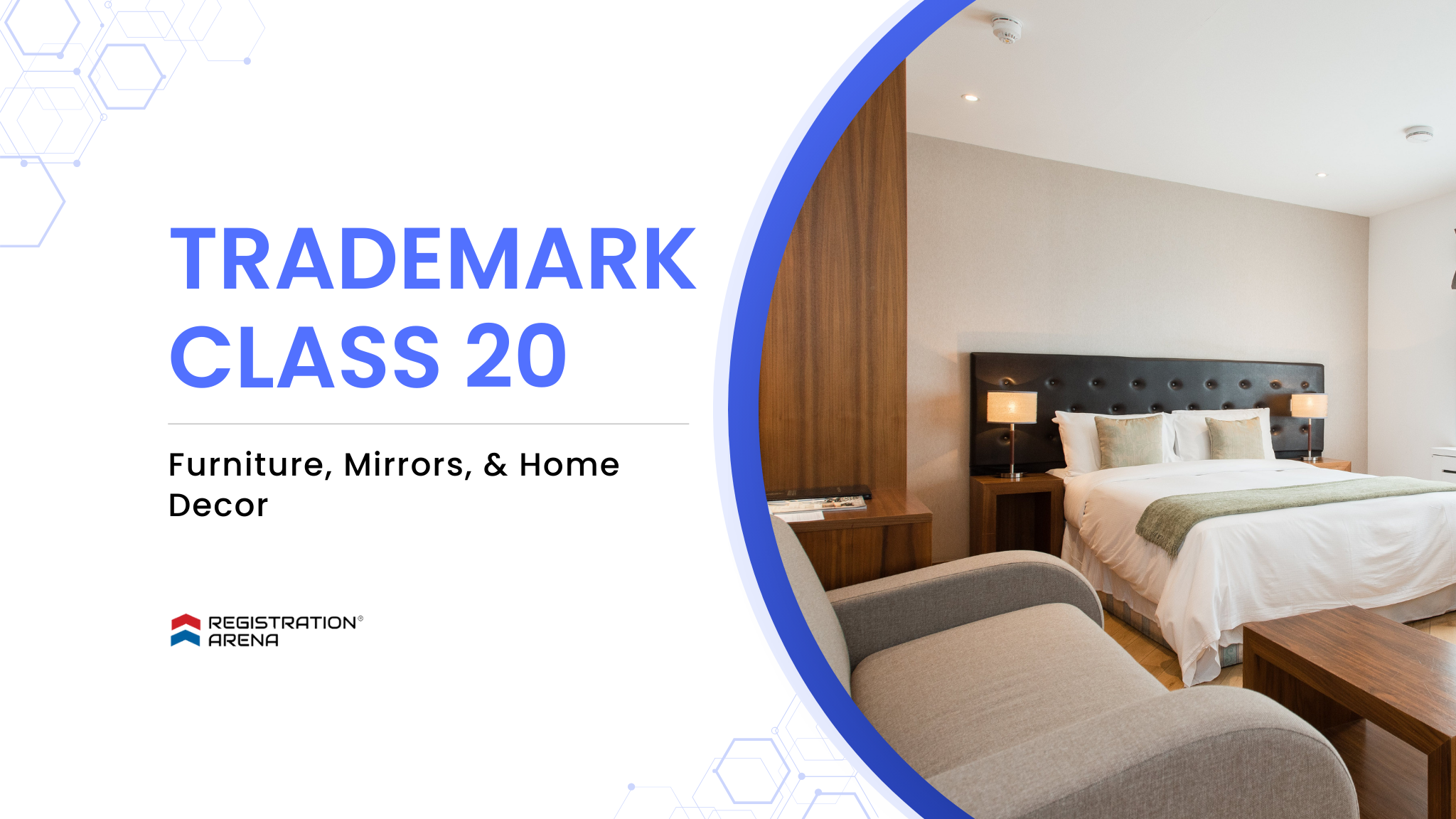
Trademark Class 21: Household, Kitchen Utensils and Glassware
Trademark Class 21 focuses on items that enhance the comfort and appeal of our homes, offering a wide range of essentials for daily living. From kitchen tools to decorative glassware, this class meets both functional needs and design preferences, making it an integral part of daily life.
This class represents the art of improving living spaces with both practical and stylish items and encompasses a wide range of products such as Household or kitchen utensils and containers; cookware and tableware, except forks, knives, and spoons; combs and sponges; brushes, except paintbrushes; brush-making materials; articles for cleaning purposes; unworked or semi-worked glass, except building glass; glassware, porcelain, and earthenware.
It mainly includes small, hand-operated utensils and apparatus for household and kitchen use, as well as cosmetic utensils, glassware, and certain goods made of porcelain, ceramic, earthenware, terra-cotta, or glass.
- Industrial Use under Trademark Class 21: Trademark Class 21 is typically used by Home goods, and kitchenware industries dealing with products such as Cookware, cleaning tools, and glassware.
- Examples of Trademark Class 21: Prestige, Anjali, Borosil, Gala, Vega, Clay Craft.
For more details, please read: Trademark Class 21 Household, Kitchen Utensils and Glassware which falls under the Trademark Class List.
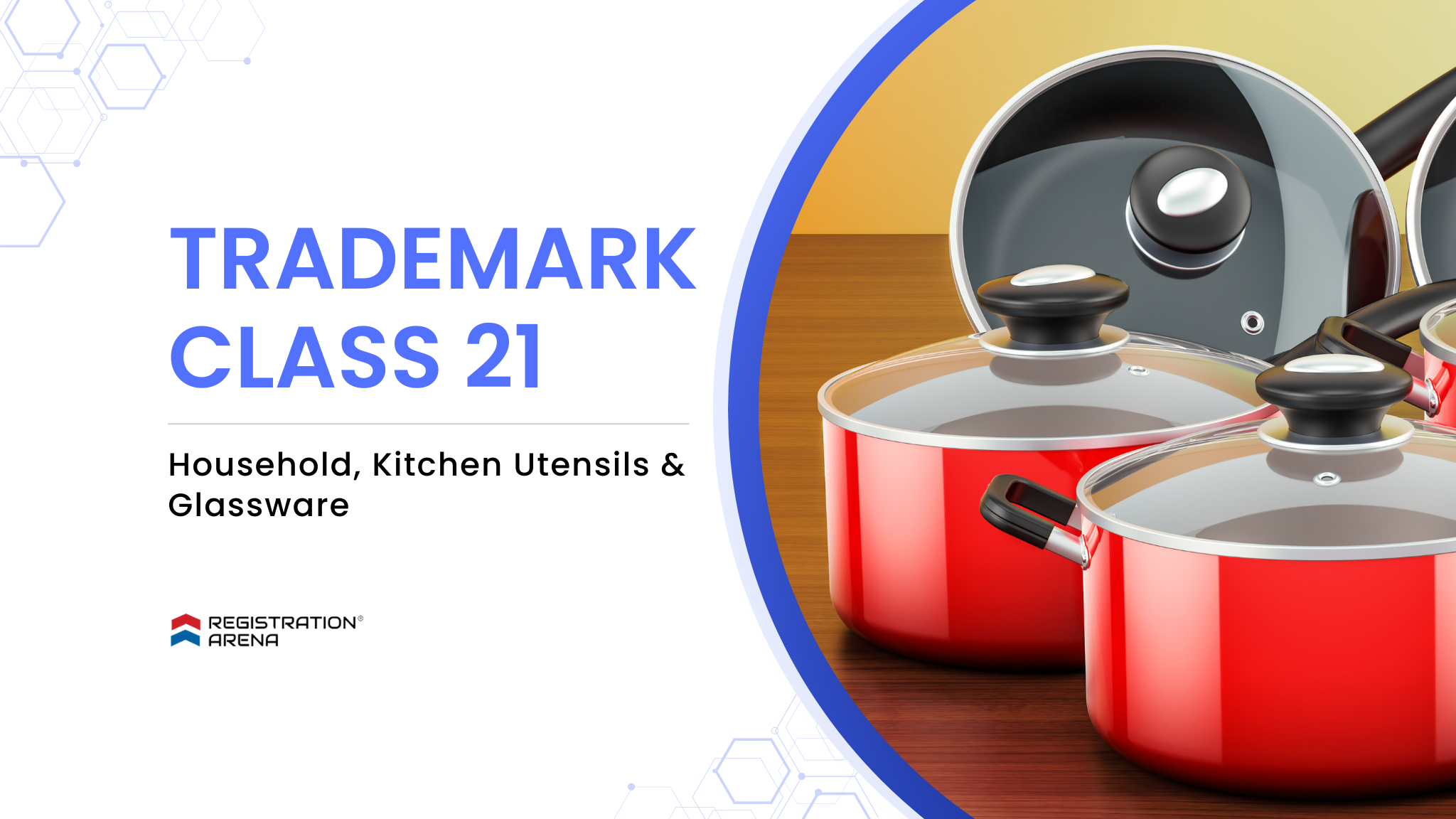
Trademark Class 22: Ropes, Tents, Sacks
Trademark Class 22 is a category focused on resilience, including a range of materials valued for their strength, durability, and versatility. From ropes that secure structures to fibers that form textiles, this class offers the essential materials used across various industries, such as construction and textiles, to create structures, fabrics, and products that are built to last.
This class encompasses a wide range of materials that are strong, durable, and versatile such as Ropes and string; nets; tents and tarpaulins; awnings of textile or synthetic materials; sails; sacks for the transport and storage of materials in bulk; padding, cushioning and stuffing materials, except of paper, cardboard, rubber or plastics; raw fibrous textile materials and substitutes therefor.
It mainly includes canvas and other materials for making sails, rope, padding, cushioning and stuffing materials, and raw fibrous textile materials.
- Industrial Use under Trademark Class 22: Trademark Class 22 is commonly used by Maritime, and construction industries for products such as Ropes, tarpaulins, and nets.
- Examples of Trademark Class 22: Kohinoor Rope, Coleman, Raymond Group, Kassim Nets, Reliance Industries Limited (Recron).
For more details, please read: Trademark Class 22 Ropes, Tents, Sacks which falls under the Trademark Class List.
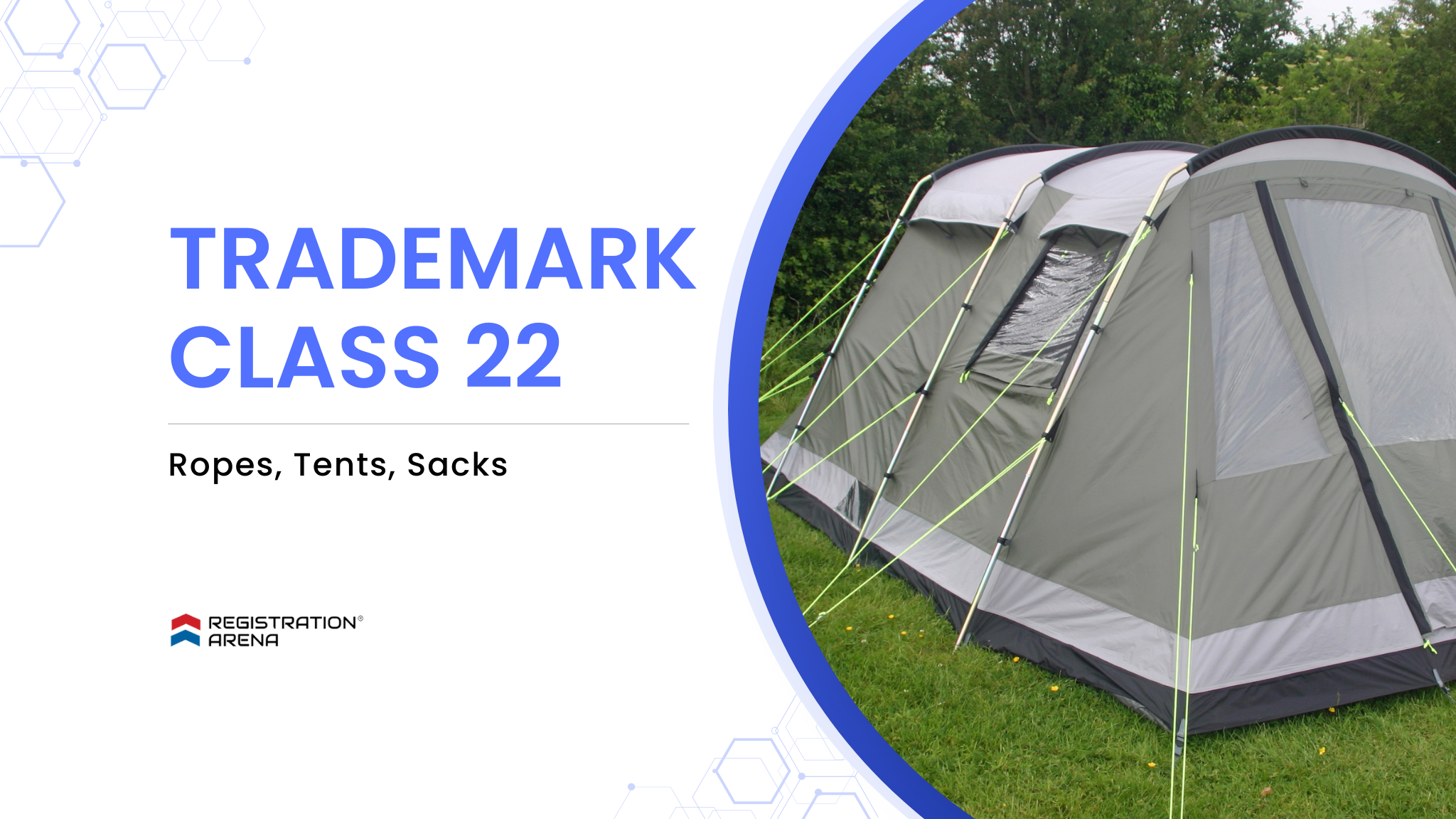
Trademark Class 23: Yarns and Threads
Trademark Class 23 is the category where textile expertise comes together, featuring a variety of yarns and threads that form the foundation of fabrics and textiles. These materials include natural fibers and synthetic threads, each with unique qualities for creative use. This class focuses on the combination of creativity and skill in textiles, from weaving to stitching garments. It encompasses a wide range of materials such as Yarns and threads for textile use. It mainly includes natural or synthetic yarns and threads for textile use.
- Industrial Use under Trademark Class 23: Trademark Class 23 is commonly used by Textile, and fashion industries dealing in products such as Sewing threads, and knitting yarns.
- Examples of Trademark Class 23: Kohinoor Rope, Coleman, Raymond Group, Kassim Nets, Reliance Industries Limited (Recron).
For more details, please read: Trademark Class 23 Yarns and Threads which falls under the Trademark Class List.

Trademark Class 24: Fabrics and Textile Products
Trademark Class 24 is a category for threads and fibers, featuring a variety of materials that shape our clothes, surroundings, and experiences. From clothing that shows our style to home textiles that offer comfort, this class combines beauty and function. It highlights a range of fabrics and products that provide warmth, elegance, and self-expression and encompasses a wide range of products such as Textiles and substitutes for textiles; household linen; and curtains of textile or plastic. It mainly includes fabrics and fabric covers for household use.
- Industrial Use under Trademark Class 24: Trademark Class 24 is commonly used by Fashion, and home textile industries dealing in products such as Fabrics, bed linens, and curtains.
- Examples of Trademark Class 24: Raymond, Bombay Dyeing, Trident, D’ Decor, Park Avenue.
For more details, please read: Trademark Class 24 Fabrics and Textile Products which falls under the Trademark Class List.

Trademark Class 25: Clothing, Footwear and Headwear
Trademark Class 25 is a category of garments where fashion and personal style merge, reflecting cultural trends and individual expression. This class includes a wide range of clothing items, from everyday basics like T-shirts and jeans to high-end fashion pieces.
Whether functional or fashionable, the garments in this class allow people to express their identity and preferences through their clothing. It is a dynamic category that encompasses a wide range of products such as Clothing, footwear, and headwear which evolves with trends, making it a crucial part of the fashion industry. It mainly includes clothing, footwear, and headwear for human beings.
- Industrial Use under Trademark Class 25: Trademark Class 25 is commonly used in Fashion and sportswear industries dealing in products such as Shirts, shoes, and hats.
- Examples of Trademark Class 25: Pantaloons, Tommy Hilfiger, Bata, Reliance Trends, Raymond.
For more details, please read: Trademark Class 25 Clothing, Footwear and Headwear which falls under the Trademark Class List.
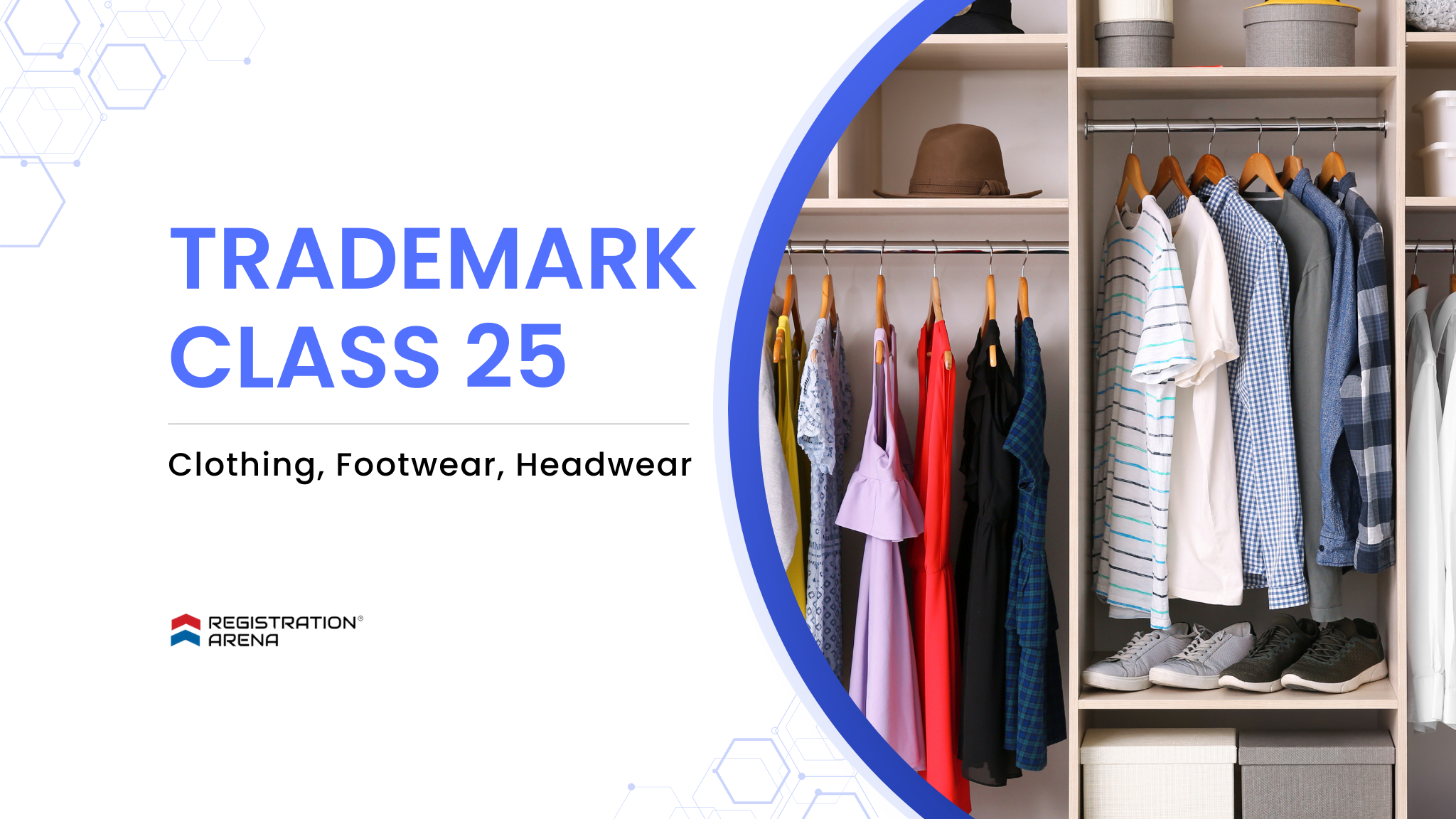
Trademark Class 26: Lace, Ribbons, Embroidery and Fancy Goods
Trademark Class 26 is a category that focuses on intricate details, encompassing a wide range of products that enhance both personal appearance and living spaces. From fashion accessories that complete an outfit to decorative items that enhance our surroundings, this class is where elegance and creativity come together.
It encompasses a variety of products that blend beauty with practicality, adding a touch of sophistication to our lives such as Lace, braid and embroidery, and haberdashery ribbons and bows; buttons, hooks and eyes, pins and needles; artificial flowers; hair decorations; false hair. It mainly includes dressmakers’ articles, natural or synthetic hair for wear, and hair adornments, as well as small decorative items intended to adorn a variety of objects, not included in other classes.
- Industrial Use under Trademark Class 26: Trademark Class 26 is commonly used by Fashion, and textiles industries dealing in products such as Ribbons, buttons, and artificial flowers.
- Examples of Trademark Class 26: Pioneer Embroideries Limited, Nish Hair, Chumbak, Feather Industries, Shoeshine.
For more details, please read: Trademark Class 26 Lace, Ribbons, Embroidery and Fancy Goods which falls under the Trademark Class List.
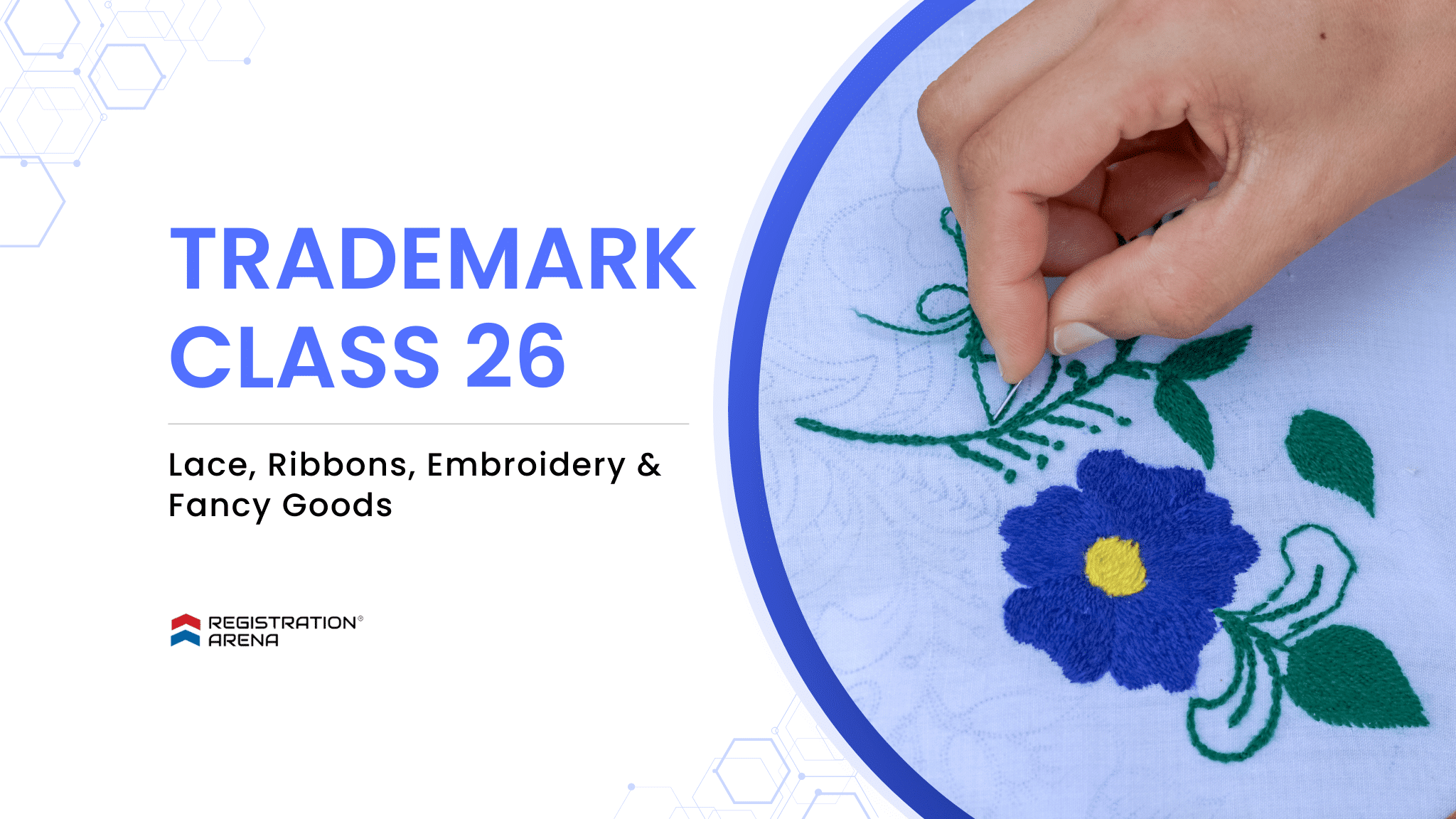
Trademark Class 27: Floor Coverings, Carpets, Rugs and Mats
Trademark Class 27 serves as the foundation that enhances both comfort and style in our living spaces. This class focuses on flooring elegance, providing materials that protect, insulate, and improve the appearance of floors. In residential, commercial, or industrial spaces, this class provides materials that bring warmth, durability, and visual appeal to different environments.
It encompasses a wide range of products such as Carpets, rugs, mats and matting, linoleum, and other materials for covering existing floors; wall hangings, not textiles. It mainly includes products intended to be added as coverings to previously constructed floors and walls.
- Industrial Use under Trademark Class 27: Trademark Class 27 is commonly used by Home decor, and flooring industries dealing in products such as Rugs, mats, and linoleum.
- Examples of Trademark Class 27: Oriental Rugs, Godrej Interio, Decathlon, Asian Paints, Gerflor.
For more details, please read: Trademark Class 27 Floor Coverings, Carpets, Rugs and Mats which falls under the Trademark Class List.
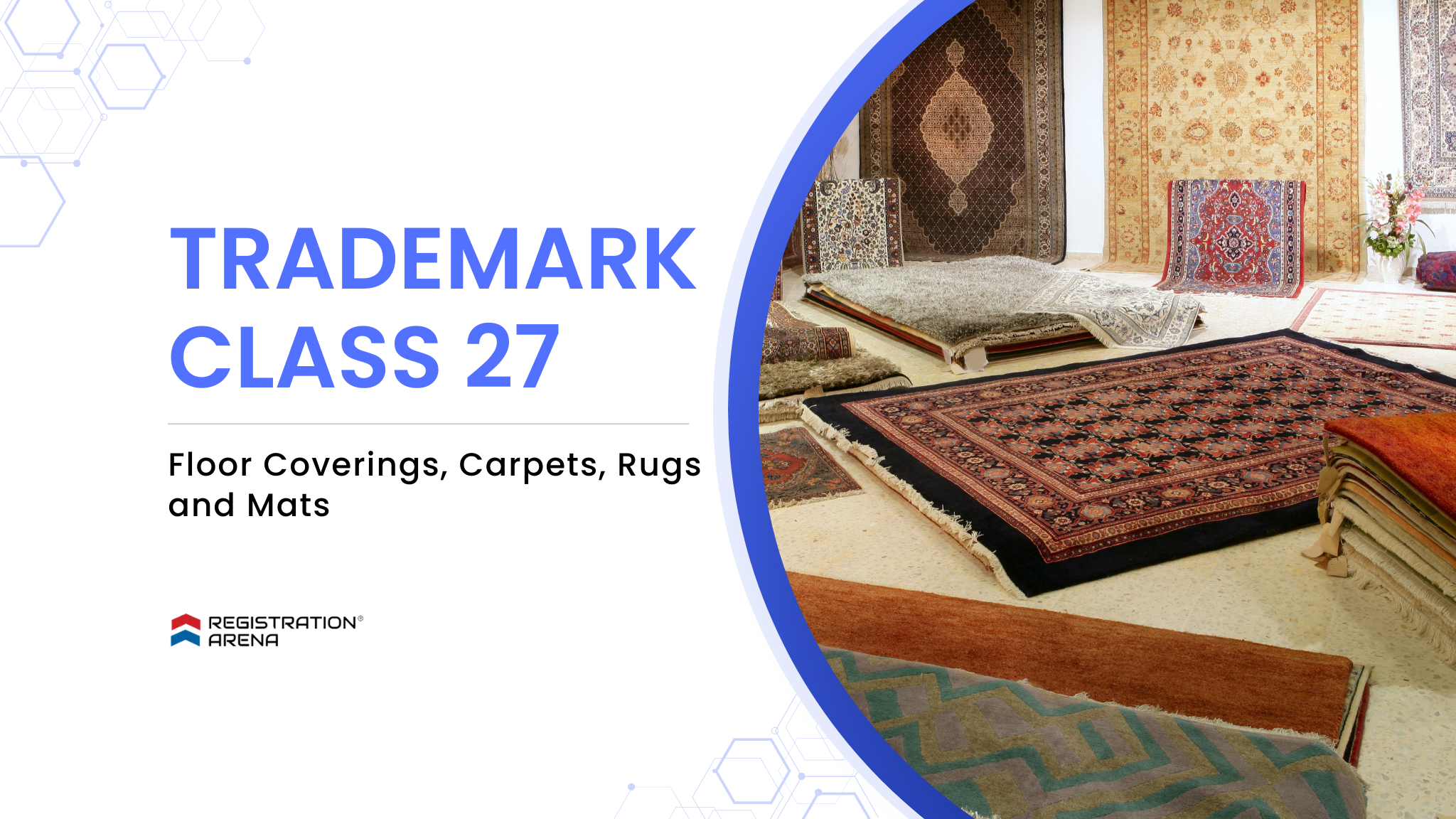
Trademark Class 28: Games, Toys, Gym and Sporting Goods
Trademark Class 28 is the center for play and sports covering a wide range of items for entertainment and physical activity. It actively celebrates fun and adventure, from the joy of play to the thrill of competition. From board games that create friendly competition to sports equipment that drives competitive spirit, this class is where leisure meets action.
This class is about recreation, encompassing a wide range of products such as Games, toys, and playthings; video game apparatus; gymnastic and sporting articles; and decorations for Christmas trees that bring joy, challenge, and excitement to both children and adults. It mainly includes toys, apparatus for playing games, sports equipment, amusement and novelty items, as well as certain articles for Christmas trees.
- Industrial Use under Trademark Class 28: Trademark Class 28 is commonly used by Entertainment, and sports industries dealing in products such as Board games, sports equipment, and toys.
- Examples of Trademark Class 28: FirstCry, Nivia, Funskool, Gold’s Gym, Trinity Christmas.
For more details, please read: Trademark Class 28 Games, Toys, Gym and Sporting Goods which falls under the Trademark Class List.
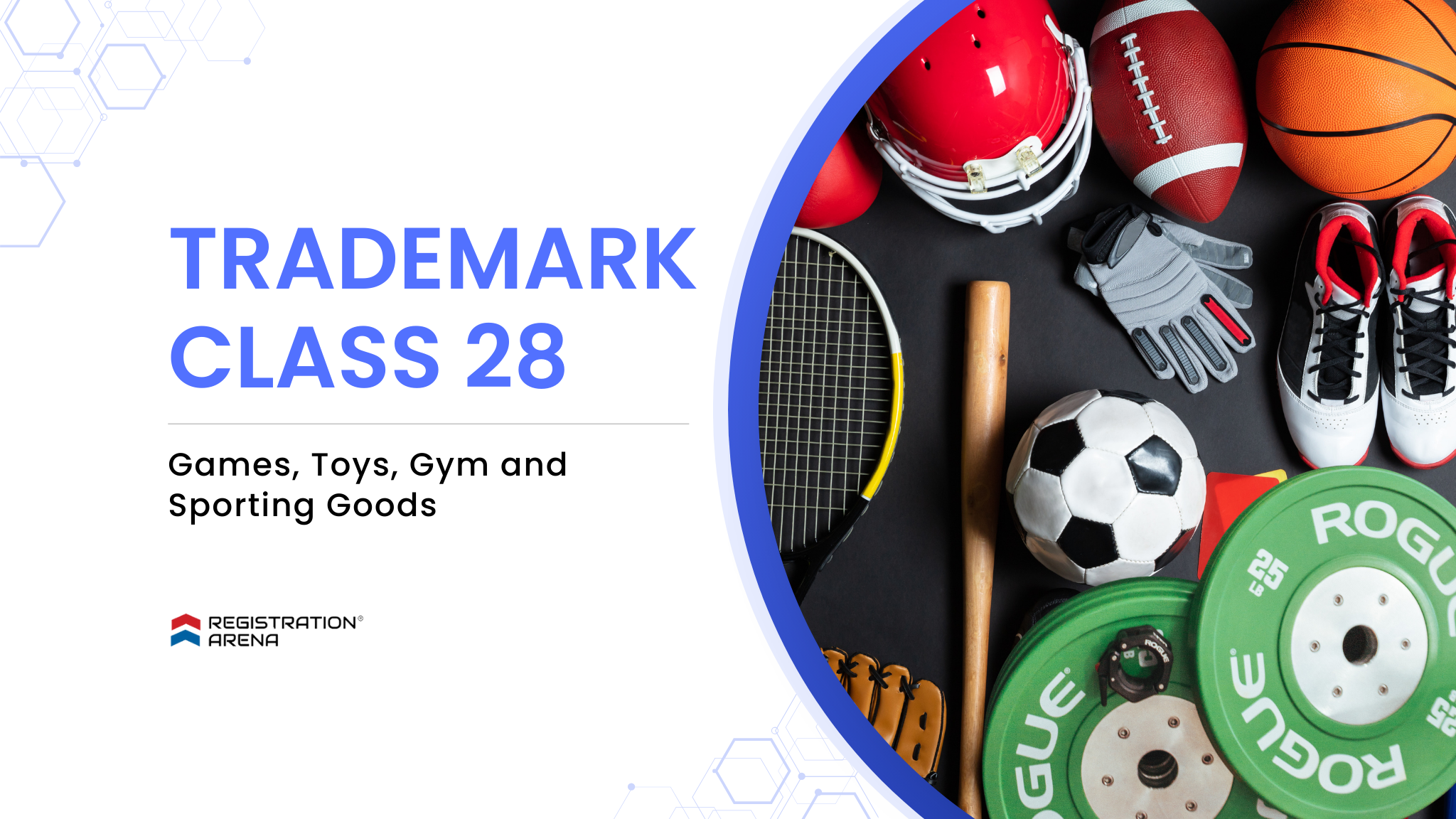
Trademark Class 29: Dairy, Meat, Poultry and Processed Foods
Trademark Class 29 is the domain of cooking delights, featuring products such as meats, poultry, and processed foods. It includes ingredients used in many recipes, catering to both home cooks and professional chefs. From savory cuts of meat to delicious processed foods, this class is where flavors come to life on our plates.
This class encompasses a wide range of products such as Meat, fish, poultry, and game; meat extracts; preserved, frozen, dried, and cooked fruits and vegetables; jellies, jams, compotes; eggs; milk, cheese, butter, yogurt, and other milk products; oils and fats for food that excite the taste buds and inspire culinary creativity. It mainly includes foodstuffs of animal origin, as well as vegetables and other horticultural comestible products that are prepared or preserved for consumption.
- Industrial Use under Trademark Class 29: Trademark Class 29 is commonly used by Food and beverage industries dealing in products such as Meat, dairy products, and canned goods.
- Examples of Trademark Class 29: Venky’s, MTR Foods, Kissan, Chitale, Fortune.
For more details, please read: Trademark Class 29 Dairy, Meat, Poultry, and Processed Foods which falls under the Trademark Class List.
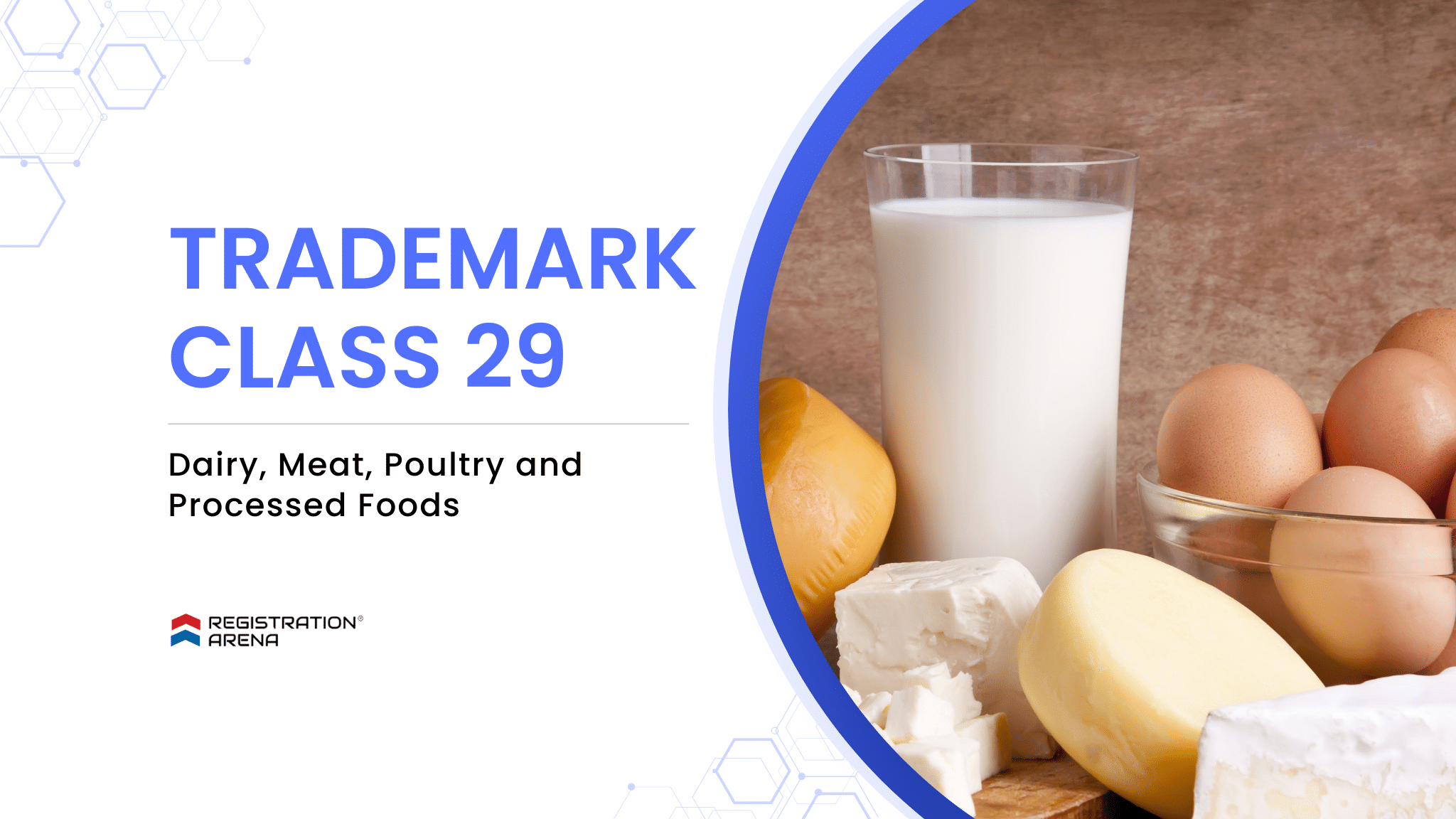
Trademark Class 30: Dairy, Meat, Poultry and Processed Foods
Trademark Class 30 represents the essence of sustenance and taste, forming the foundation of our daily diets. It is the category of sustenance and flavor, covering a diverse array of edible products that serve as the nutritional basis for communities around the globe. From bread and rice to spices and sauces, this class celebrates the universal pleasures of eating while offering the essentials for a balanced diet.
This class encompasses a wide range of food products such as Coffee, tea, cocoa and substitutes therefor; rice, pasta, and noodles; tapioca and sago; flour and preparations made from cereals; bread, pastries, and confectionery; chocolate; ice cream, sorbets and other edible ices; sugar, honey, treacle; yeast, baking-powder; salt, seasonings, spices, preserved herbs; vinegar, sauces and other condiments; ice (frozen water) that nourish our bodies and delight our palates.
It mainly includes foodstuffs of plant origin, except fruits and vegetables, prepared or preserved for consumption, as well as auxiliaries intended for the improvement of the flavor of food.
- Industrial Use under Trademark Class 30: Trademark Class 30 is commonly used by Food and beverage industries dealing in products such as Coffee, sugar, and pastries.
- Examples of Trademark Class 30: Nescafé, Daawat, Modern, Maggi, MDH (Mahashian Di Hatti), and Kissan.
For more details, please read: Trademark Class 30 Dairy, Meat, Poultry, and Processed Foods which falls under the Trademark Class List.
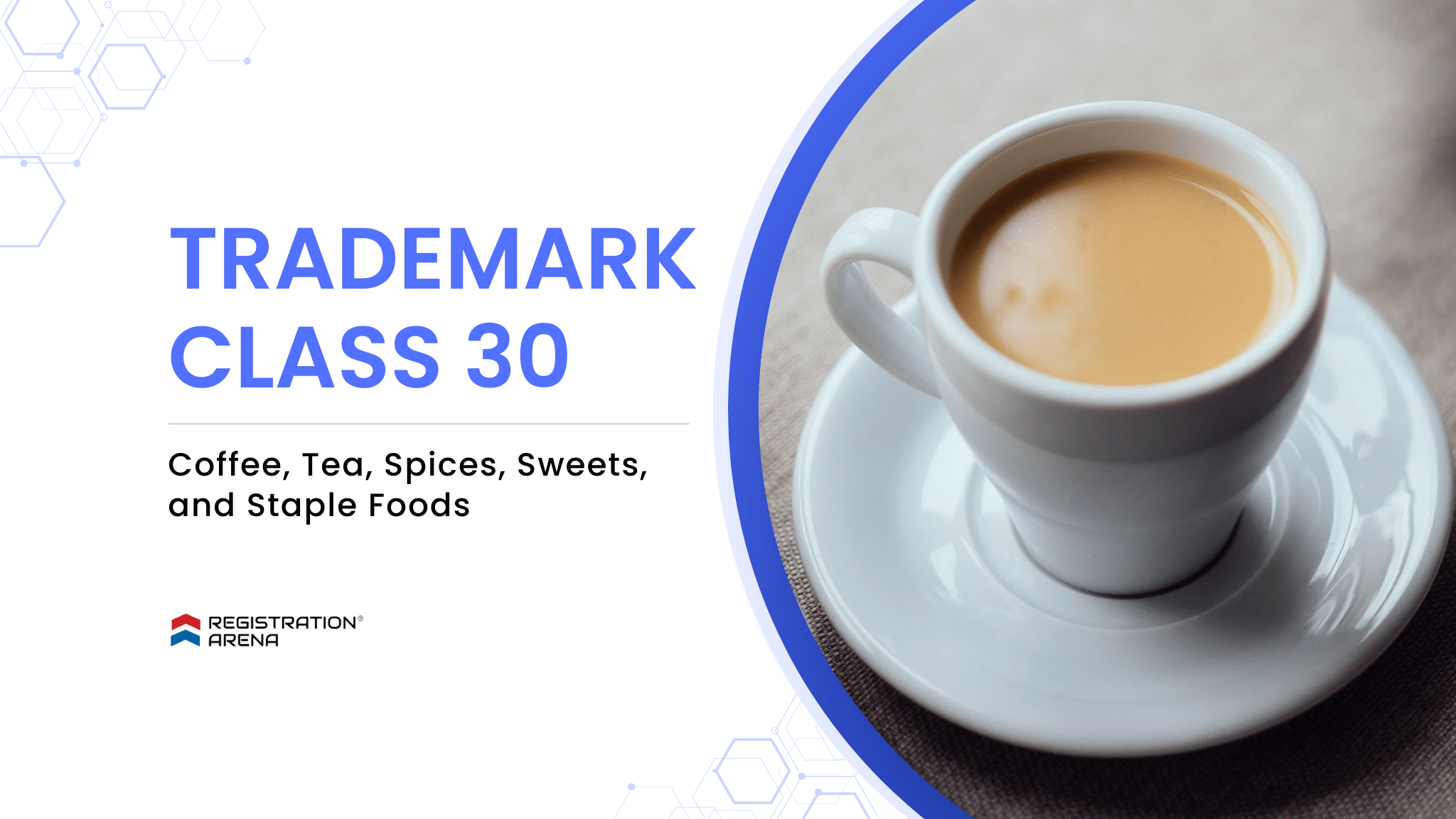
Trademark Class 31: Agricultural Products, Fruits and Vegetables
Trademark Class 31 serves as the guardian of the Earth’s vitality and nourishment. This class encompasses the riches harvested from the soil, including nourishing foods and vibrant plant life. From the harvests of crops to the beauty of flowers, this class highlights how important farming is in feeding us and lifting our spirits.
This class covers the world of nature’s richness, containing a wide range of products that come from the fertile fields of agriculture such as Raw and unprocessed agricultural, aquacultural, horticultural, and forestry products; raw and unprocessed grains and seeds; fresh fruits and vegetables, fresh herbs; natural plants and flowers; bulbs, seedlings and seeds for planting; live animals; foodstuffs and beverages for animals; malt.
It mainly includes land and sea products not having been subjected to any form of preparation for consumption, live animals and plants as well as foodstuffs for animals.
- Industrial Use under Trademark Class 31: Trademark Class 31 is commonly used by Agriculture, horticulture, gardening, and animal husbandry industries dealing in products such as Seeds, live animals, fresh fruits, and vegetables.
- Examples of Trademark Class 31: BigBasket, Tata Sampann Supergrain, Mahyco Grow, Pedigree, Ferns N Petals.
For more details, please read: Trademark Class 31 Agricultural Products, Fruits and Vegetables which falls under the Trademark Class List.
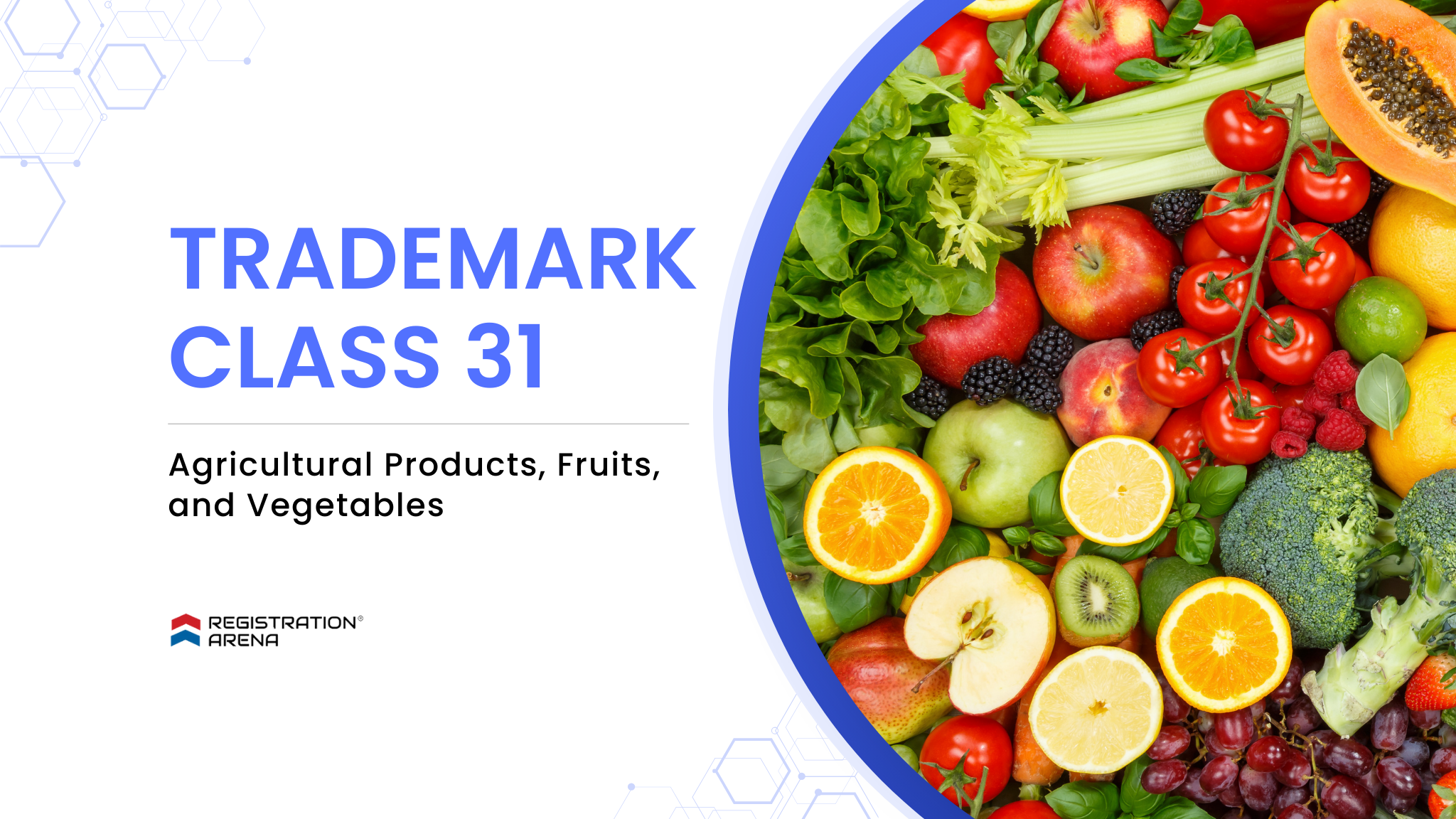
Trademark Class 32: Beers, Waters and Non-Alcoholic Drinks
Trademark Class 32 stands as the place of refreshment and enjoyment, offering drinks that energize our senses and enhance our leisure time It encompasses a variety of refreshing non-alcoholic beverages, offering something to suit every palate and preference. From sparkling drinks to refreshing blends, it represents beverages that make everyday moments better.
This class covers a variety of drinks such as Beers; non-alcoholic beverages; mineral and aerated waters; fruit beverages and fruit juices; syrups and other preparations for making non-alcoholic beverages that suit different tastes and preferences. It mainly includes non-alcoholic beverages, as well as beer.
- Industrial Use under Trademark Class 32: Trademark Class 32 is commonly used by Food and beverage industries dealing in products such as Soft drinks, fruit juices, and mineral water.
- Examples of Trademark Class 32: PepsiCo India, Bisleri International, Tropicana, Revive, Red Bull, and Kingfisher.
For more details, please read: Trademark Class 32: Beers, Waters, and Non-Alcoholic Drinks which falls under the Trademark Class List.

Trademark Class 33: Alcoholic Beverages except Beer
Trademark Class 33 represents the world of refined taste and celebration, encompassing a wide variety of alcoholic beverages, from wines to distilled spirits. It reflects the artistry involved in crafting beverages that delight the senses and enhance moments of joy and togetherness. From the rich flavors of fine wines to the complex tastes of aged spirits, it showcases the elegance of taste and the long-standing tradition behind these drinks.
This class covers a variety of drinks such as Alcoholic beverages, except beers; alcoholic preparations for making beverages. It mainly includes alcoholic beverages, essences, and extracts.
- Industrial Use under Trademark Class 33: Trademark Class 33 is commonly used by Beverage and hospitality industries dealing in products such as Wine, beer, and spirits.
- Examples of Trademark Class 33: Sula Vineyards, Dom Pérignon Champagne, McDowell’s No. 1, Old Monk, Paul John Brandy, and Grand Marnier.
For more details, please read: Trademark Class 33: Alcoholic Beverages Except Beer which falls under the Trademark Class List.
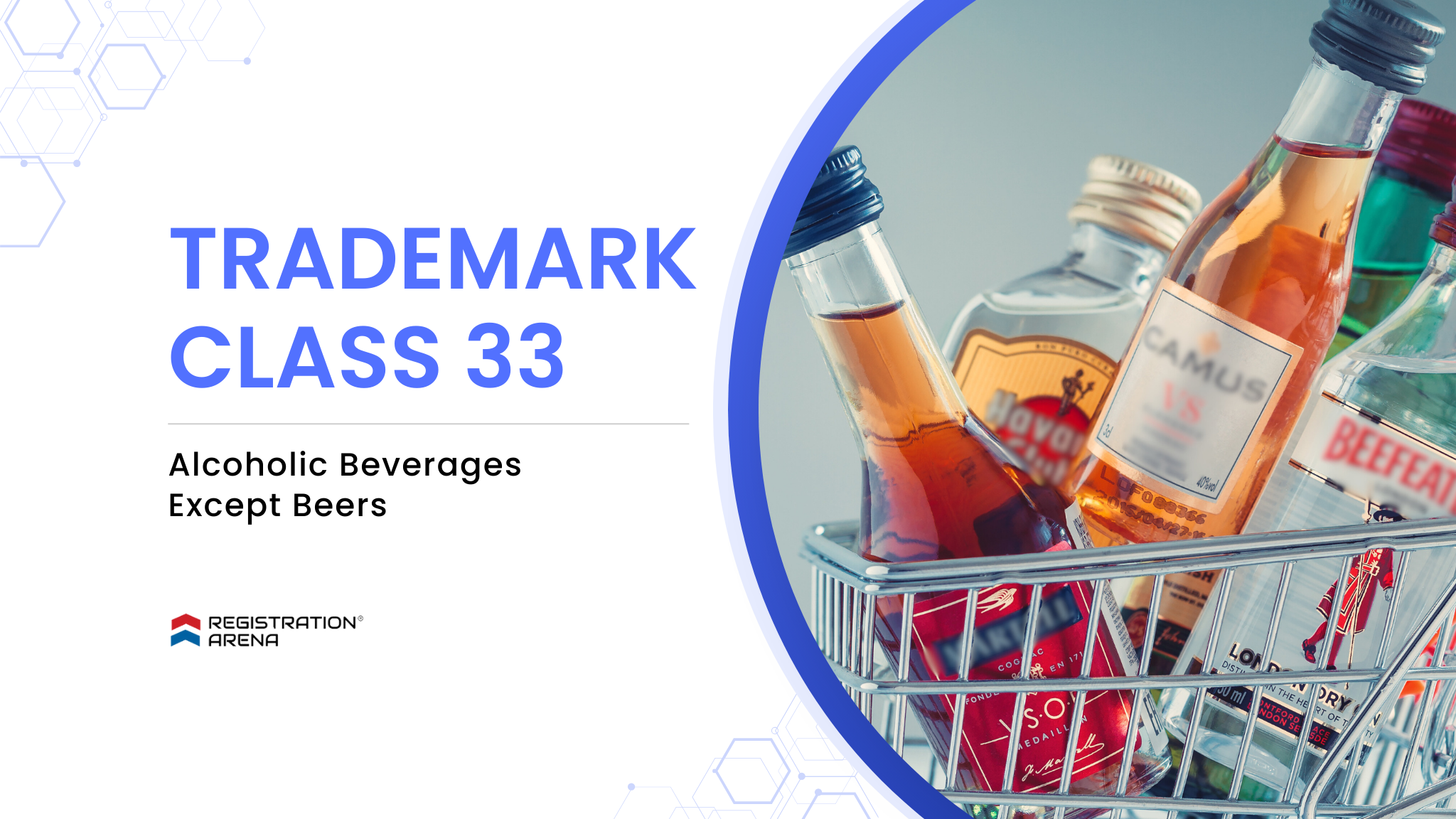
Trademark Class 34: Tobacco, Cigarettes, Smokers Article
Trademark Class 34 focuses on tobacco products, showcasing the smell and experience of tobacco. It includes items that bring out different feelings and attitudes, ranging from enjoyment to personal style choices. From cigarettes to cigars, this class includes products that have played a significant role in societies for centuries, often connected with cultural traditions, individual preferences, and discussions about health concerns.
This class covers a variety of products made from the tobacco plant such as Tobacco and tobacco substitutes; cigarettes and cigars; electronic cigarettes and oral vaporizers for smokers; smokers’ articles; and matches. It mainly includes tobacco and articles used for smoking, as well as certain accessories and containers related to their use.
- Industrial Use under Trademark Class 34: Trademark Class 34 is commonly used by Tobacco, and lifestyle industries dealing in products such as Cigarettes, lighters, and tobacco pipes.
- Examples of Trademark Class 34: Gold Flake, Ashton, NJOY, Manikchand, VIP.
For more details, please read: Trademark Class 34 Tobacco, Cigarettes, Smokers Article which falls under the Trademark Class List.
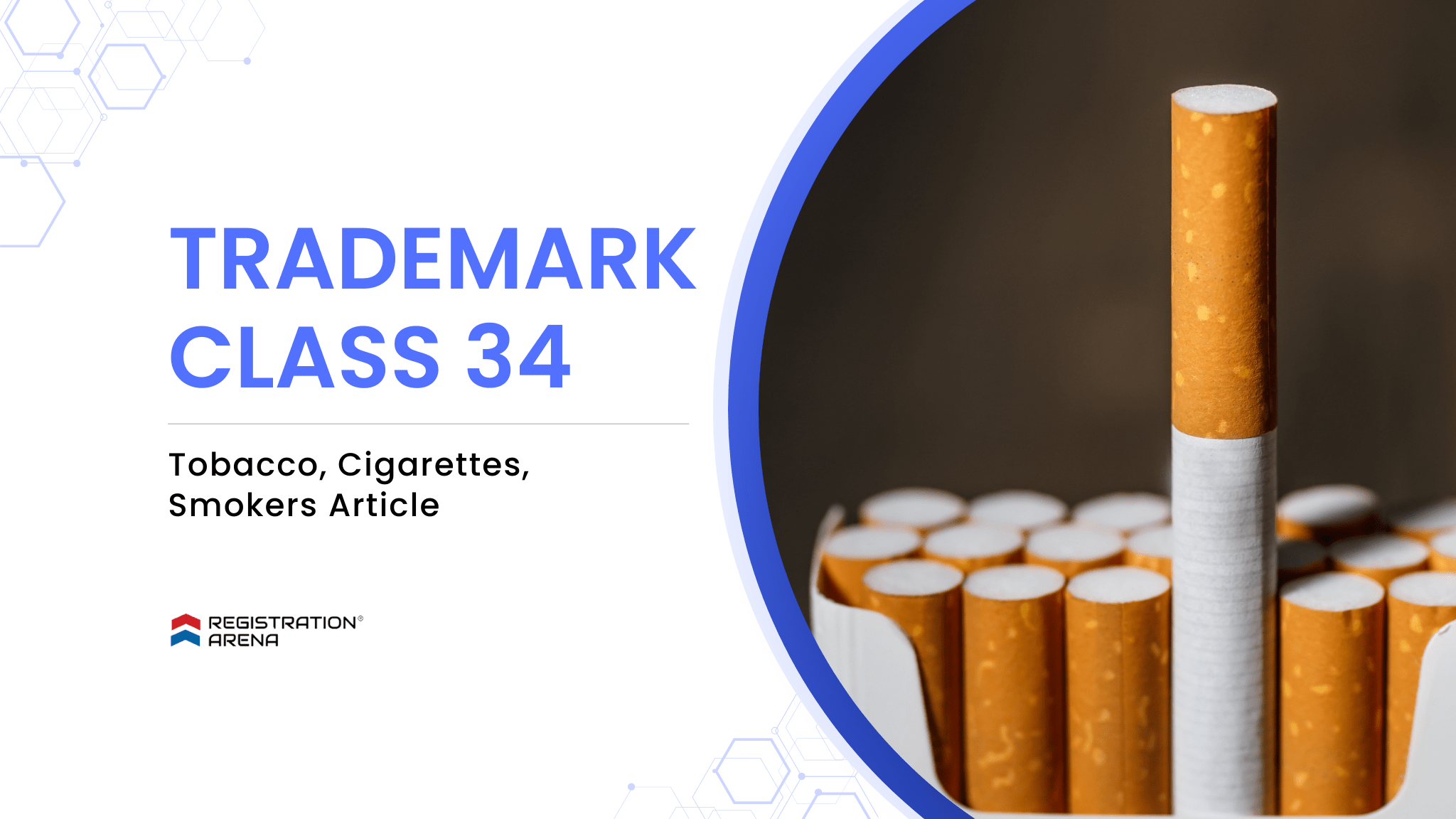
Trademark Class List 35 to 45 for Services
Trademark Class 35: Advertising, Business, Retail Services
Trademark Class 35 is a guide for businesses looking to grow their presence and reach more people. This class is all about empowering businesses, featuring a variety of services aimed at enhancing companies and brands. From advertising products and services to optimizing operations and enabling transactions, it acts as a central point where strategy, execution, and growth come together.
This class includes various services such as Advertising, Business, and Retail Services that support marketing strategies, enable commerce, and promote brand growth. It mainly includes services involving business management, operation, organization, and administration of a commercial or industrial enterprise, as well as advertising, marketing, and promotional services. For the purposes of classification, the sale of goods is not considered to be a service.
- Industrial Use under Trademark Class 35: Trademark Class 35 is commonly used by industries such as Marketing and business services for services such as Advertising, market research, and office administration.
- Examples of Trademark Class 35: Google, Tata, DMart, Amazon Connect, TNS.
For more details, please read: Trademark Class 35 Advertising, Business, Retail Services which falls under the Trademark Class List.

Trademark Class 36: Financial, Banking and Insurance Services
Trademark Class 36 emerges as the protector of financial security and forward-thinking planning. This class represents the domain of financial security and strategic planning, including services that handle money matters, investment options, and risk management. From insuring valuable belongings to planning for retirement, it connects financial stability with future goals.
This class includes various services such as Financial, monetary, and banking services; insurance services; real estate services that protect our assets, plan for the future, and guide us through the complexities of financial matters. It mainly includes services relating to banking and other financial transactions, financial valuation services, as well as insurance and real estate activities.
- Industrial Use under Trademark Class 36: Trademark Class 36 is commonly used by industries such as Finance and Insurance for services such as Banking, insurance brokerage, and real estate services.
- Examples of Trademark Class 36: LIC (Life Insurance Corporation of India), Kotak Mahindra Bank, Aditya Birla Ventures, DLF Limited, PricewaterhouseCoopers (PwC) India.
For more details, please read: Trademark Class 36 Financial, Banking and Insurance Services which falls under the Trademark Class List.

Trademark Class 37: Construction, Repair and Installation Services
Trademark Class 37 serves as the foundation upon which structures are built and excellence is renewed. This class is the domain of transformation, encompassing services that involve constructing new structures from scratch as well as renovating and maintaining existing ones. From constructing impressive buildings to restoring worn-out spaces, Class 37 is crucial in shaping our physical world.
This class includes various services such as Construction services; installation and repair services; mining extraction, and oil and gas drilling that shape our built environment and rejuvenate existing structures. It mainly includes services in the field of construction, as well as services involving the restoration of objects to their original condition or their preservation without altering their physical or chemical properties.
- Industrial Use under Trademark Class 37: Trademark Class 37 is commonly used by industries such as Construction, and maintenance for services such as Construction, renovation, and installation.
- Examples of Trademark Class 37: Tata Projects, Sulekha, Blue Star Limited, Coal India, and Gauri Khan Designs.
For more details, please read: Trademark Class 37 Construction, Repair, and Installation Services which falls under the Trademark Class List.

Trademark Class 38: Telecommunications and Broadcasting
Trademark Class 38 serves as the link that connects modern societies together. It represents the field of connectivity, offering a wide range of services that allow the exchange of information, data, and voice across different platforms and mediums. From voice calls that close distances to data transmission that drives the digital world, this class forms the backbone of our interconnected world.
This class covers technologies and services such as telecommunications services that go beyond geographical boundaries, allowing communication and data exchange on a global level. It mainly includes services that allow at least one party to communicate with another, as well as services for the broadcasting and transmission of data.
- Industrial Use under Trademark Class 38: Trademark Class 38 is commonly used by industries such as Communications, and IT for services such as Telecommunication services, internet services, and broadcasting.
- Examples of Trademark Class 38: Airtel, Reliance Jio, Whatsapp, Cisco Webex, Gmail.
For more details, please read: Trademark Class 38 Telecommunications and Broadcasting which falls under the Trademark Class List.
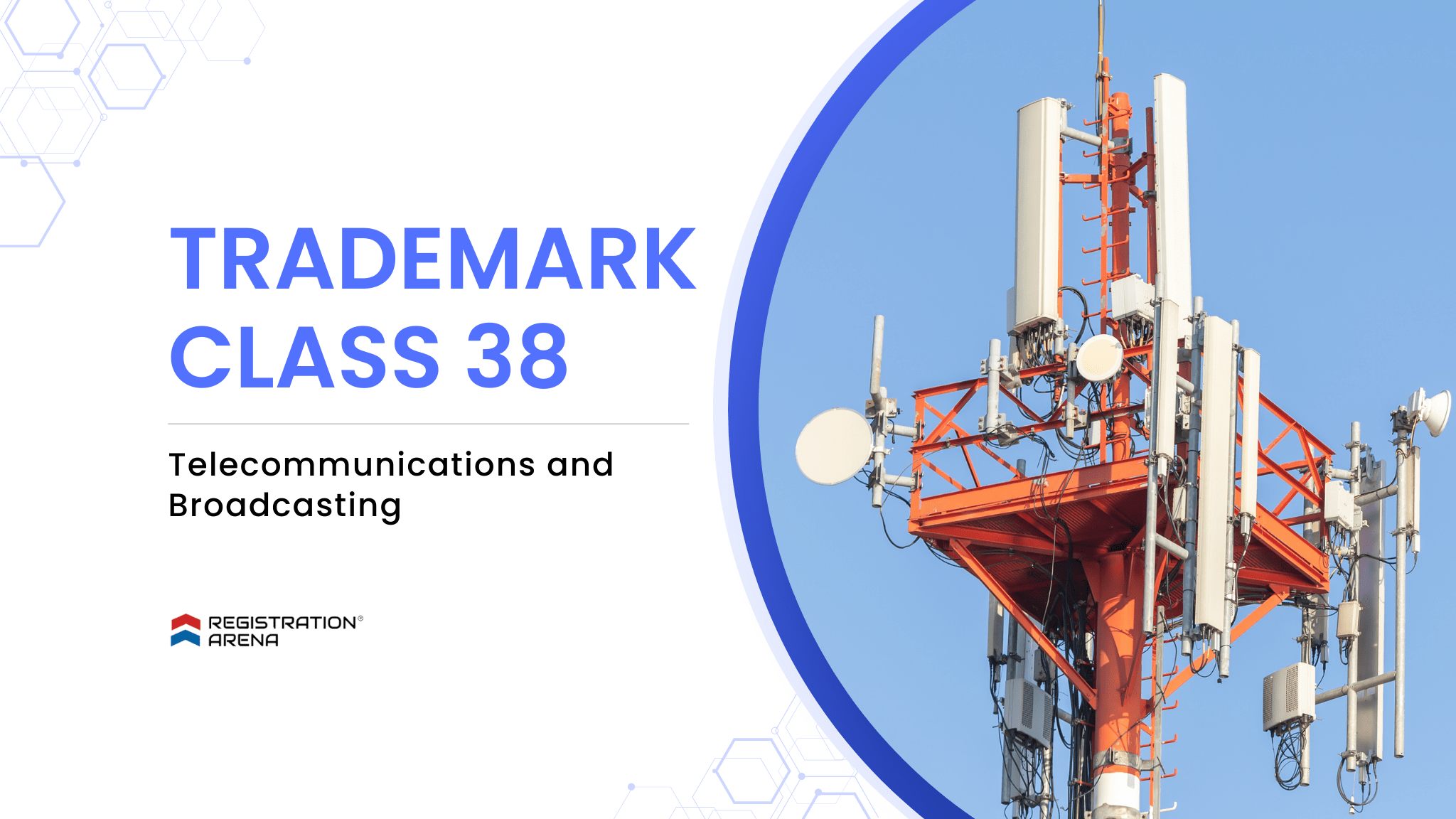
Trademark Class 39: Transport, Packaging and Storage Services
Trademark Class 39 stands as the leader of logistics and safekeeping, guiding through the world of transportation and storage. It acts as the coordinator of transport and protection, offering services that cover transportation, delivery, and storage. From delivering packages to managing global supply chains, this class drives commerce forward while protecting valuable assets.
This class covers services such as Transport; packaging and storage of goods; travel arrangements, ensuring the smooth movement of goods, and their secure storage. It mainly includes services for the transport of people, animals, or goods from one place to another by rail, road, water, air, or pipeline and services necessarily connected with such transport, as well as the storing of goods in any kind of storage facility, warehouses or other types of building for their preservation or guarding.
- Industrial Use under Trademark Class 39: Trademark Class 39 is commonly used by industries such as Logistics, and travel for services such as Freight transport, warehousing, and travel agency services.
- Examples of Trademark Class 39: Ola Cabs, Allcargo Logistics Ltd., DTDC Express Limited, Future Supply Chain Solutions, Kesari Tours, Zoomcar.
For more details, please read: Trademark Class 39 Transport, Packaging, and Storage Services which falls under the Trademark Class List.

Trademark Class 40: Printing and Treatment of Materials
Trademark Class 40 represents the domain where raw materials are transformed into valuable assets through specialized processes. It acts as the realm of refinement and specialization, encompassing a wide range of services dedicated to treating raw materials and transforming them to meet specific requirements.
From refining raw materials to creating finished products, this class brings forth the art of turning resources into something new and useful. This class covers services aimed at improving the quality, functionality, and appearance of materials such as Treatment of materials; recycling of waste and trash; air purification and treatment of water; printing services; and food and drink preservation.
It mainly includes services rendered by the mechanical or chemical processing, transformation, or production of objects or inorganic or organic substances, including custom manufacturing services. For the purposes of classification, the production or manufacturing of goods is considered a service only in cases where it is effected for the account of another person to their order and specification.
If the production or manufacturing is not being performed to fulfill an order for goods that meet the customer’s particular needs, requirements, or specifications, then it is generally ancillary to the maker’s primary commercial activity or goods in trade. If the substance or object is marketed to third parties by the person who processed, transformed, or produced it, then this would generally not be considered a service.
- Industrial Use under Trademark Class 40: Trademark Class 40 is commonly used by industries such as Manufacturing, recycling for services such as Material processing, metal treatment, and recycling services.
- Examples of Trademark Class 40: Metal One, Raymond Group, Pureit (HUL), Canon, GEPIL (Green Environment Protection & Industrial Limited), and Dabur India Ltd.
For more details, please read: Trademark Class 40: Printing and Treatment of Materials which falls under the Trademark Class List.

Trademark Class 41: Education and Entertainment Services
Trademark Class 41 represents the domain where people share knowledge, express creativity, and provide entertainment. It acts as a hub of growth and inspiration, offering a range of services that encourage learning, creativity, and entertainment. From educational institutions to cultural performances, this class serves as the channel that enriches minds and captivates hearts.
This class covers services such as Education; providing of training; entertainment; sporting and cultural activities that help people learn, encourage creativity, and bring joy and wonder. It mainly includes services consisting of all forms of education or training, services having the basic aim of the entertainment, amusement, or recreation of people, as well as the presentation of works of visual art or literature to the public for cultural or educational purposes.
- Industrial Use under Trademark Class 41: Trademark Class 41 is commonly used by industries such as Education, entertainment for services such as Teaching services, film production, and sports activities.
- Examples of Trademark Class 41: Savitribai Phule Pune University, Zee Entertainment Enterprises Ltd., The Indian Premier League (IPL), NCPA (National Centre for the Performing Arts), E-Factor.
For more details, please read: Trademark Class 41 Education and Entertainment Services which falls under the Trademark Class List.

Trademark Class 42: Scientific and Technological Services
Trademark Class 42 represents the domain where technology, research, and innovation come together to shape the future. It is the center of innovation, offering a variety of services that help industries grow and advance human knowledge. From software design and development to scientific research and consulting, this class serves as the foundation of innovation in a constantly changing world.
This class includes a wide range of services such as Scientific and technological services and research and design relating thereto; industrial analysis, industrial research, and industrial design services; quality control and authentication services; design and development of computer hardware and software that fuel technological progress, scientific discovery, and effective problem-solving.
It mainly includes services provided by persons in relation to the theoretical and practical aspects of complex fields of activities, for example, scientific laboratory services, engineering, computer programming, architectural services, or interior design.
- Industrial Use under Trademark Class 42: Trademark Class 42 is commonly used by industries such as Technology, research. for services such as Scientific research, IT consulting, and design services.
- Examples of Trademark Class 42: Tata Consultancy Services (TCS), Wipro, Amazon Cloud, Accenture, Bluehost India.
For more details, please read: Trademark Class 42 Scientific and Technological Services which falls under the Trademark Class List.

Trademark Class 43: Hospitality, Food, Drinking Services
Trademark Class 43 is renowned for creating unforgettable food and hospitality experiences. It represents a world of comfort and culinary pleasure, offering a variety of services to meet the needs and desires of travelers and diners. From boutique hotels to renowned dining spots, this class is a haven of luxury, flavor, and hospitality.
This class includes services for providing food and drink; and temporary accommodation that bring the art of creating memorable experiences to life for both travelers and diners. It mainly includes services provided in relation to the preparation of food and drink for consumption, as well as services for providing temporary accommodation.
- Industrial Use under Trademark Class 43: Trademark Class 43 is commonly used by industries such as Hospitality, foodservice for services such as Restaurant services, catering, and temporary accommodation.
- Examples of Trademark Class 43: Taj Hotels, Barbeque Nation, Shiv Sagar, Starbucks, Airbnb.
For more details, please read: Trademark Class 43 Hospitality, Food, Drinking Services which falls under the Trademark Class List.
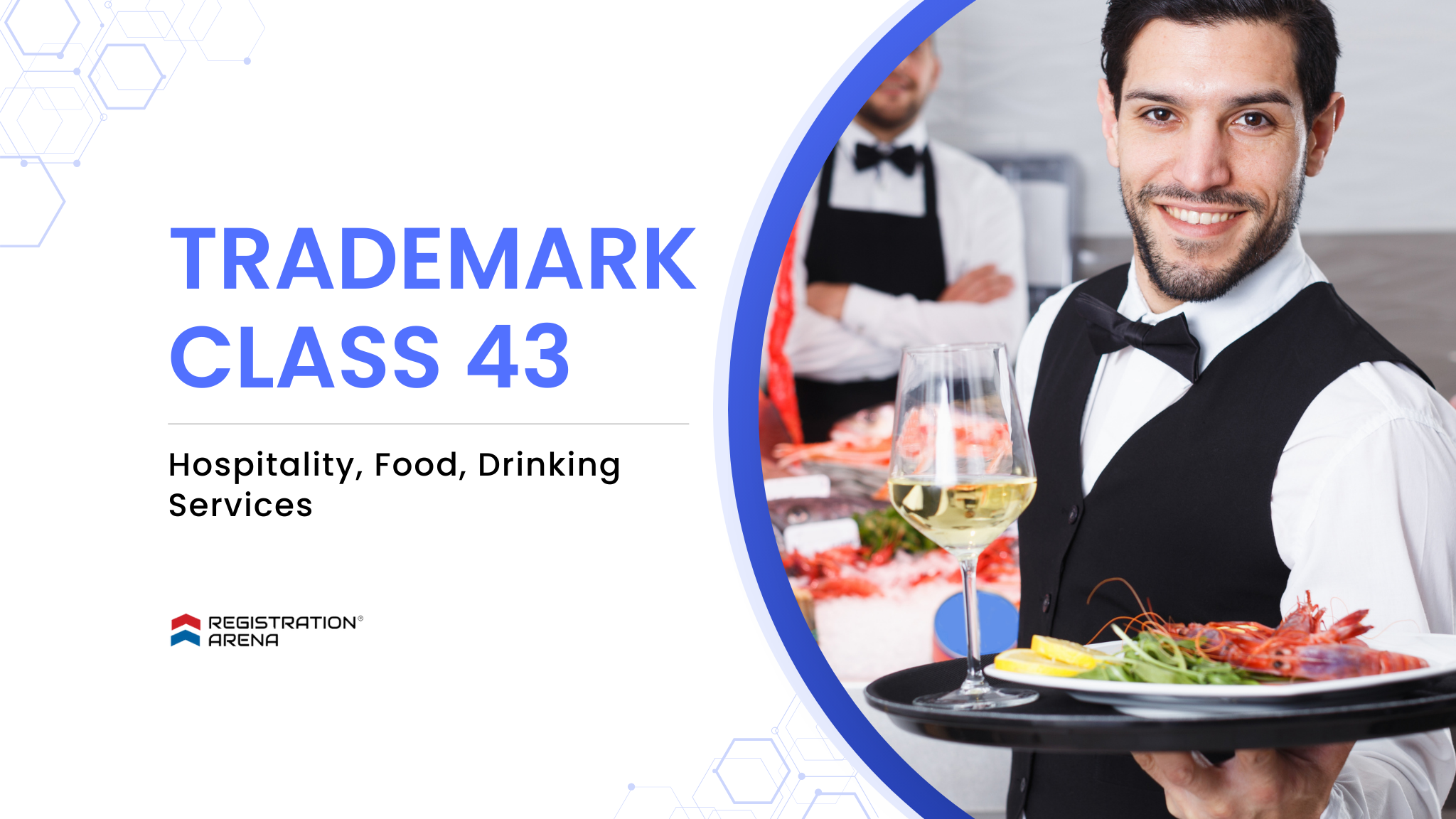
Trademark Class 44: Medical, Agriculture, Veterinary Services
Trademark Class 44 represents the domain of care and transformation, encompassing services related to health and beauty. It acts as a haven for health and aesthetics, offering services that span from medical diagnostics and treatments to beauty enhancements and self-care. From healing medical treatments to confidence-boosting beauty services, this class is where science meets aesthetics.
This class includes a wide range of services such as Medical services; veterinary services; hygienic and beauty care for human beings or animals; agriculture, aquaculture, horticulture, and forestry services designed to promote well-being, restore vitality, and improve appearance.
It mainly includes medical care, alternative medicine, hygienic and beauty care given by persons or establishments to human beings and animals, as well as services relating to the fields of agriculture, aquaculture, horticulture, and forestry.
- Industrial Use under Trademark Class 44: Trademark Class 44 is commonly used by industries such as Healthcare, and veterinary for services such as Medical treatment, veterinary care, and beauty treatments.
- Examples of Trademark Class 44: Apollo Hospitals, Lakmé Salon, Clove Dental, Mahindra Agribusiness, and Dr. Batra’s.
For more details, please read: Trademark Class 44 Medical, Agriculture, Veterinary Services which falls under the Trademark Class List.

Trademark Class 45: Legal, Security and Social Services
Trademark Class 45 emerges as the protector of personal security and legal integrity. It represents the domain of protection and justice, encompassing services focused on personal safety, legal representation, and maintaining societal order. From helping individuals protect their rights to upholding the principles of fairness and equity, this class serves as a pillar of strength and assurance.
This class includes a wide range of services such as Legal services; security services for the physical protection of tangible property and individuals; dating services, online social networking services; funerary services; and babysitting that protect individuals, support communities, and ensure the sanctity of justice. It mainly includes legal and security services, as well as certain personal and social services rendered by others to meet the needs of individuals.
- Industrial Use under Trademark Class 45: Trademark Class 45 is commonly used by industries such as Legal, security for services such as Legal advice, security services, and personal protection.
- Examples of Trademark Class 45: Registration Arena, Aegis Security, Bharat Matrimony, AuthBridge, and Noble Sparrows.
For more details, please read: Trademark Class 45 Legal, Security, and Social Services which falls under the Trademark Class List.
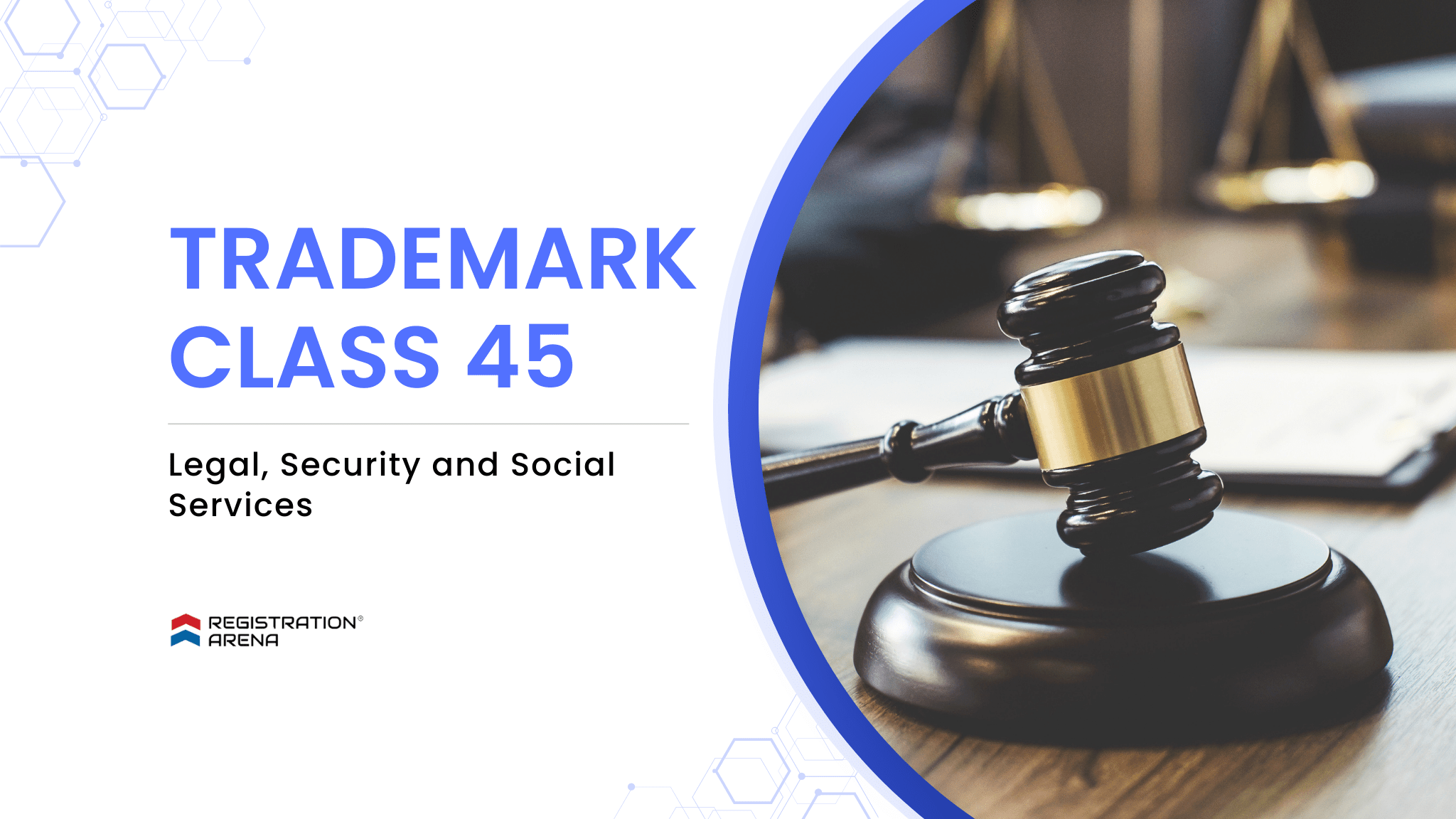
How to make a TM Search and Select the Right one from the Trademark Class List?
Preliminary Trademark Search
Before registering your trademark, it’s important to make a detailed trademark search to ensure that a similar trademark isn’t already in use. Conducting this trademark search can assist in saving time and money by avoiding potential issues with existing registered marks.
Selecting the Appropriate Trademark Class
Determine the class or classes under which your goods or services fall. The International Classification of Goods and Services under the Nice Agreement categorizes products and services into 45 different classes. Example: If you want to name your product as “ SONY” and the category under which your product falls is class 9 (which covers electronics). You are required to insert that word on search within that class to make sure that no one else has taken it.
Public Search on the official website
Search can be carried out online through the official website (https://tmrsearch.ipindia.gov.in/tmrpublicsearch/) of the Trademarks Registry.
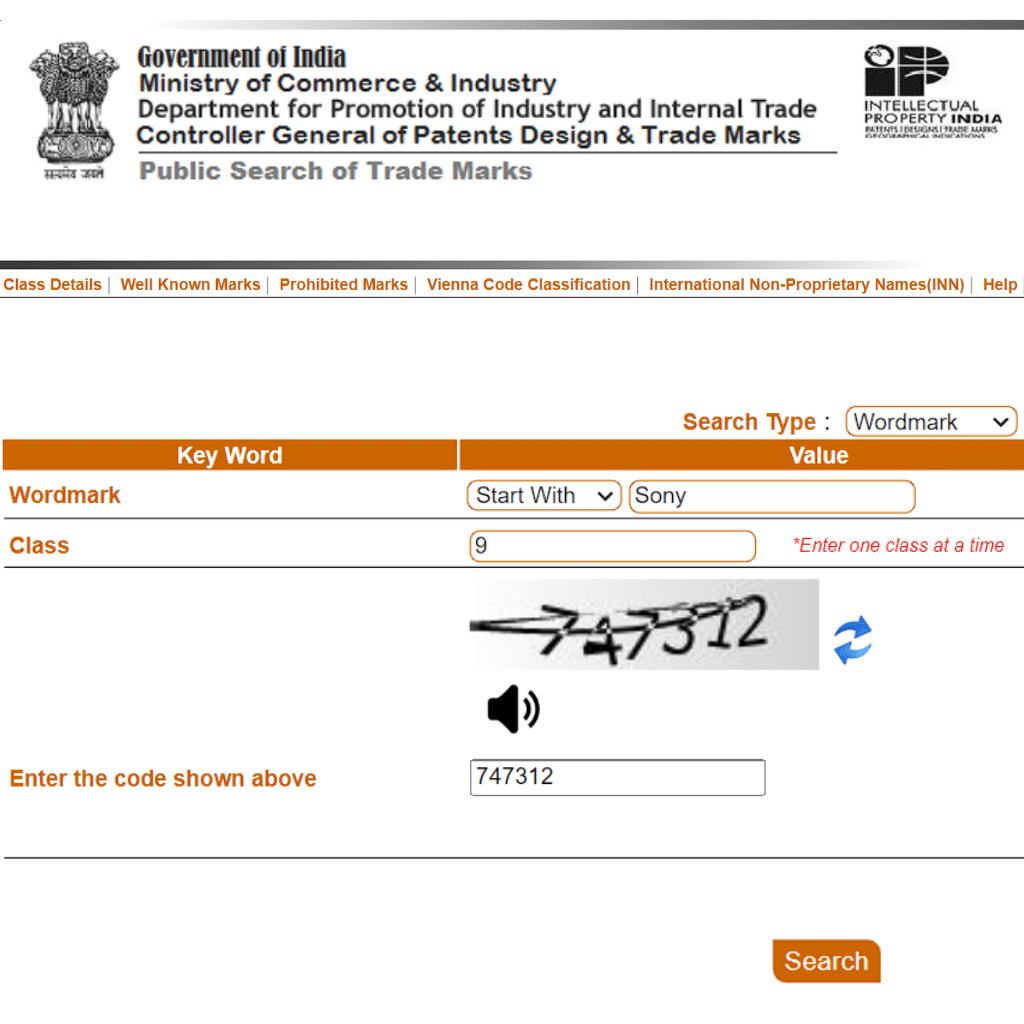
Analyzing the results
After carrying out the trademark search, we need to identify any similar trademarks, particularly within your industry, and assess whether these existing marks could create confusion among consumers.
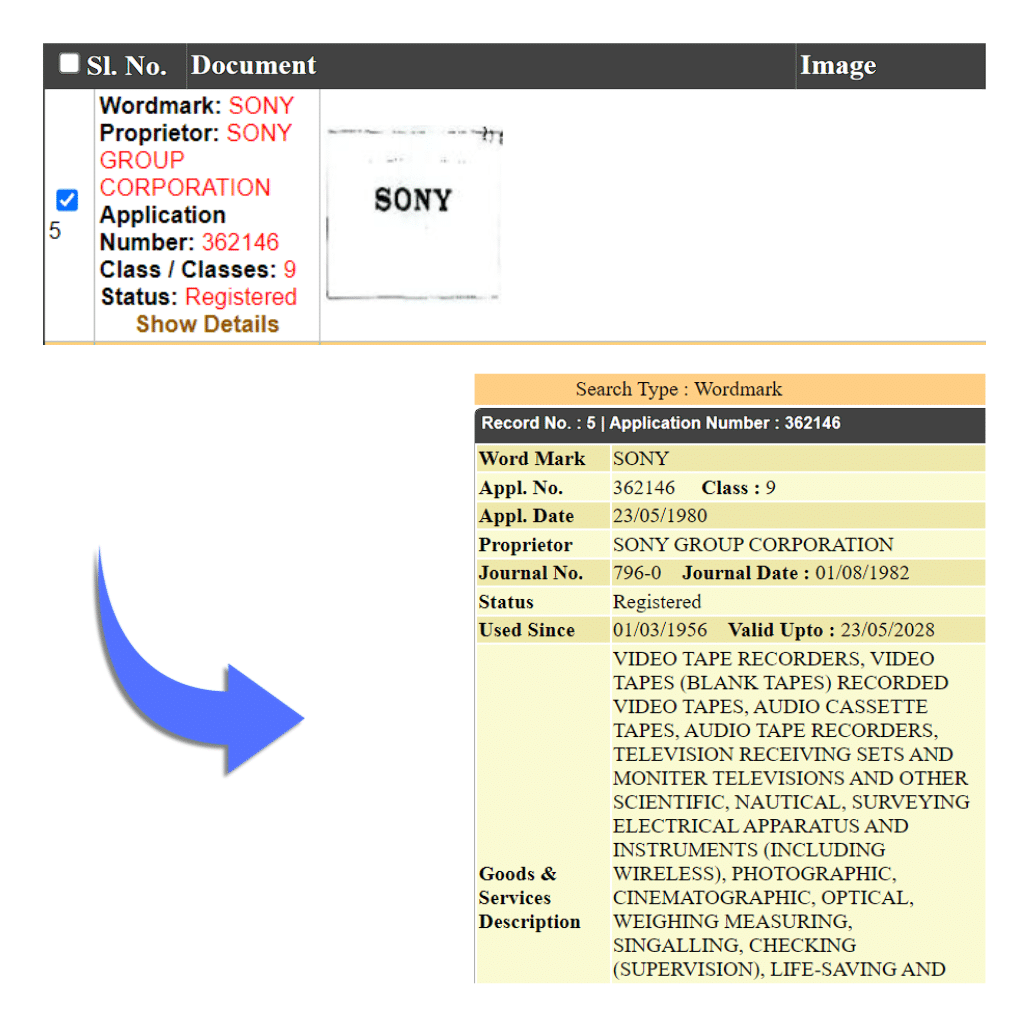
Seek professional help
If you’re new and unsure how to proceed with trademark registration, we at Registration Arena can help you choose the appropriate class and guide you through the Trademark Registration Process.
Conclusion on Trademark Class list
Trademark classes categorize goods and services into 45 groups, making protecting your brand in specific areas easier. Trademark Class plays an important role in trademark registration because it accurately determines the amount of protection for your trademark.
It ensures that your mark is exclusively protected for the goods or services that you provide, avoiding unnecessary difficulties with businesses in nearby regions. Choosing the correct class is an essential step in protecting your brand’s uniqueness and preventing future legal issues.
Contact us today to benefit from our expert trademark registration services. We can help you identify the appropriate trademark class and successfully navigate the registration process.
FAQs on Trademark Class List
Which classification system is used in India for the registration of trademarks?
India follows the NICE Classification of Goods and Services for the purpose of registration of trademarks. The NICE Classification groups goods and services into 45 classes (classes 1-34 include goods and classes 35-45 include services).
What types of products are covered under Trademark Class 29?
Trademark Class 29 covers a variety of products, including meat, fish, poultry, dairy products, edible oils and fats, processed fruits and vegetables, preserves, pickles, sauces, nuts, seeds, and prepared meals and snacks.
Is there a specific class for food and restaurant services in trademark classification?
Yes, restaurant services fall under Class 43 of the trademark classification system, which includes services related to providing food, drink, and temporary accommodations.
Can I register my trademark in multiple classes?
Yes, one can apply for a trademark through a multiclass trademark registration when the same trademark is used for goods and services that come under different trademark classes to get complete trademark protection against infringement.
Do trademark classes affect the scope of protection?
Yes, the trademark class determines the scope of protection. A trademark is only protected within the classes in which it is registered, so proper classification is crucial for safeguarding your brand.
